Alternate AIME Math Jam
Go back to the Math Jam ArchiveWe will review the problems from the 2005 Alternate AIME.
Copyright © 2025 AoPS Incorporated. This page is copyrighted material. You can view and print this page for your own use, but you cannot share the contents of this file with others.
Facilitator: Mathew Crawford
MCrawford (19:29:27)
2005 Alternate AIME Math Jam
Before we get started I would like to take a moment to explain our virtual classroom to those who have not previously participated in a Math Jam or one of our online classes.
MCrawford (19:29:36)
The classroom is moderated meaning that students can type into the classroom, but only the moderators can choose a comment to drop into the classroom. This helps keep the class organized and on track. This also means that only well-written comments will be dropped into the classroom, so please take time writing responses that are complete and easy to read.
MCrawford (19:29:45)
Also, only moderators can enter into private chats with other people in the classroom. You can copy the contents of a private chat by clicking on the notebook icon on the private chat window and copying and pasting the contents into a file on your own computer.
MCrawford (19:29:56)
Finally, the virtual classroom is TeX enabled. TeX allows users to make nice equations and other math expressions. If you would like to learn how to write in TeX/LaTeX, click on the tab on the left side panel of our site and there is a tutorial and reference guide there.
MCrawford (19:30:01)
Using TeX in the virtual classroom is slightly different than using it on the message board or in a TeX editor. If anything you type up in a post that uses TeX then you must use a semicolon (;) to begin your post. For example, if you type
MCrawford (19:30:05)

MCrawford (19:30:08)
This message will look like this when posted in the classroom:
MCrawford (19:30:12)

MCrawford (19:30:17)
Just remember, if your post uses TeX, use the semicolon (;) to begin your post!
MCrawford (19:30:30)
Problem 1:
MCrawford (19:30:32)

MCrawford (19:30:37)
//s3.amazonaws.com/classroom.artofproblemsolving.com/Classroom/cbe6/images/lx-57718334.gif
MCrawford (19:30:41)
How can we approach this problem?
kky1638 (19:30:43)
use combination I guess
edummit (19:30:50)
combinations
codeblue87 (19:30:56)
combinations
MCrawford (19:31:04)
It seems that we first need expressions for the numbers of ways in which we can select 3 and 6 cards from the deck.
MCrawford (19:31:08)

justdudxit (19:30:57)
set up an equation
jen7 (19:30:59)
C(n,6)=6C(n,3)
dts (19:31:14)

MCrawford (19:31:24)

justdudxit (19:31:20)
How'd you do that in Tex
MCrawford (19:31:33)
\binom{n}{6}
MCrawford (19:31:40)
How can we approach this equation?
fedwinri (19:31:44)
Write it out
codeblue87 (19:31:48)
cancel factorials
kky1638 (19:31:50)
simplify?
TechTroid (19:31:55)
use facorials
Mildorf (19:31:57)

MCrawford (19:32:07)

MCrawford (19:32:21)
Now what?
Someone (19:32:24)
simplify numerical coefficients
kky1638 (19:32:26)
get rid of n factorial on the top!
dts (19:32:29)
Cancel stuff out.
MCrawford (19:32:36)

MCrawford (19:32:39)

MCrawford (19:32:45)

edummit (19:32:34)
Cancel factors
codeblue87 (19:32:35)
expand the factorial expressions
MCrawford (19:33:01)

MCrawford (19:33:15)
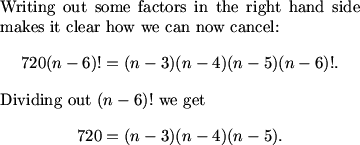
Mildorf (19:32:53)

MCrawford (19:33:26)
We could go about solving a cubic equation, but at this point we recognize that 720 must be the product of 3 consecutive integers that relate to our answer. What is n?
justdudxit (19:33:35)
720 = 8*9*10. n=013
kky1638 (19:33:43)
13
edummit (19:33:44)
720 is 10 times 9 times 8, so n is 13.
MCrawford (19:33:49)
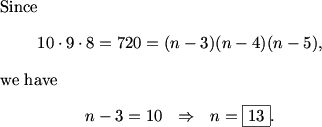
Mildorf (19:33:42)
Excuse my typo. (That should actually be 6 * 6 * 5 * 4)
MCrawford (19:33:59)
This problem tested our understanding of combinations and how they are defined in terms of the algebra. We also saw the principle of equating two same quantities, a common theme in algebraic problem solving.
dts (19:33:55)
*sigh*, at this point, I used the rational roots theorem...
MCrawford (19:34:09)
Combinations are discussed in detail in the AoPS Introduction to Counting & Probability class.
MCrawford (19:34:33)
What dts did is what might be described as, ""killing a housefly with a bazooka.""
MCrawford (19:34:42)
Problem 2:
MCrawford (19:34:44)
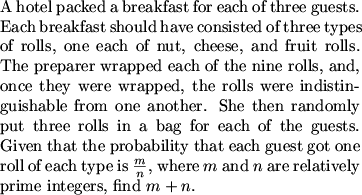
MCrawford (19:34:51)
//s3.amazonaws.com/classroom.artofproblemsolving.com/Classroom/cbe6/images/lx-69173438.gif
MCrawford (19:34:56)
Here we have a counting probability problem. How can we approach it?
justdudxit (19:35:06)
Good orders/All orders
fedwinri (19:35:23)
Casework almost works best since we only need to consider the first 6 choices.
edummit (19:35:26)
Look at conditional probabilities: first guest 1, then guest 2, then guest 3. Then multiply.
yif man12 (19:35:27)
get probability that the first person gets the right stuff
MCrawford (19:35:42)
If we focus on the rolls received by each guest, we can work this problem as an independent probability problem.
MCrawford (19:35:48)
What is the probability that the first guest receives rolls of all three types?
yif man12 (19:36:12)
9/28
jen7 (19:36:13)
9*6*3/9*8*7
TechTroid (19:36:21)
9/9 * 6/8 * 3/7
MCrawford (19:36:35)
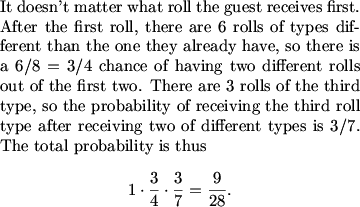
edummit (19:36:43)
The first roll can be anything; the second roll can be any of the other 6 (of 8 total); the third can be 3 of the remaining 7. Thus (3/4) times (3/7).
MCrawford (19:36:57)
What is the probability that the second guest receives rolls of all three types given that the first guest did?
TechTroid (19:37:18)
6/6*4/5*2/4
edummit (19:37:47)
The first roll can be anything (again); the second roll can be any of the other 4 (of 5 total); the third can be any of the other 2 (of 4 total). Thus (4/5) times (1/2), or 2/5.
pika (19:38:05)
1*4/5*2/4
fedwinri (19:38:07)
(6/6)*(4/5)*(2/4) = 2/5
Someone (19:38:03)
2/5
MCrawford (19:38:18)
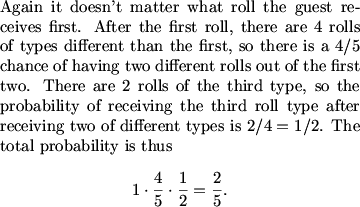
MCrawford (19:38:29)
Now what?
MCrawford (19:38:43)
What about the third guest?
Someone (19:38:39)
third prob is 1
jen7 (19:38:46)
probability 3rd guest gets different is 1
edummit (19:38:46)
The third guest always ends up with the last 3 rolls, so the probability there is 1.
TechTroid (19:38:48)
third is 1
MCrawford (19:38:59)
If the first two guests each have rolls of all three types, there is one of each type left for the third guest as well.
What is our answer?
TechTroid (19:38:39)
multiply
fedwinri (19:38:49)
The third is good to go--- multiply those two together.
edummit (19:39:08)
7/90.
Someone (19:39:16)
9/70
pika (19:39:21)
2/5*9/28
edummit (19:39:23)
9/70...
fedwinri (19:39:27)

MCrawford (19:39:38)
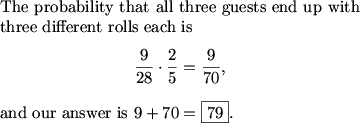
justdudxit (19:39:16)

NightFlarer (19:39:52)
couldn't you also just do (27*8)/(C(9,3)*C(6,3))?
MCrawford (19:40:24)
Yes, we could do that too. It all amounts to the same thing.
dts (19:40:14)
I did it that way, but botched a calculation somewhere.
MCrawford (19:40:43)
That's part of the reason I break problems down into parts -- it's easier to identify mistakes sometimes.
MCrawford (19:41:01)
And when checking your answers, it's good to check using a distinct method.
MCrawford (19:41:07)
You'll catch more errors that way.
MCrawford (19:41:18)
The key to this problem was recognizing that we could focus on one guest at a time and that the circumstances for each calculation were independent by our selection process.
Independent probability is discussed in detail in the AoPS Introduction to Counting & Probability class.
edummit (19:41:17)
I originally did it the second way during the test, and then checked it using the first method.
MCrawford (19:41:30)
Problem 3:
MCrawford (19:41:31)

MCrawford (19:41:39)
//s3.amazonaws.com/classroom.artofproblemsolving.com/Classroom/cbe6/images/lx-194431198.gif
MCrawford (19:41:47)
How can we start with this problem?
dts (19:41:49)
Let the first term be a, and the common ratio be r.
kky1638 (19:41:51)
let a be the first term and k be the ratio?
MCrawford (19:42:05)
We need to translate this problem from words into the language of mathematics.
MCrawford (19:42:10)

MCrawford (19:42:21)

TechTroid (19:41:49)
formula for a geometric series
jen7 (19:41:50)

conartist (19:41:51)
sum of infinite geomtric series is a / 1-r
yif man12 (19:42:03)
infinite series sum is t1/(1-r)
Mildorf (19:42:22)

yif man12 (19:42:41)
a/(1-r)=2005 and (a^2)/(1-r^2)=20050
JHu (19:42:52)

Mildorf (19:42:54)

MCrawford (19:43:00)
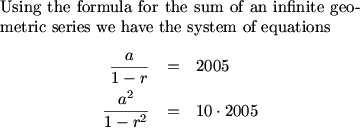
MCrawford (19:43:08)
Notice that I keep the product of 10 and 2005 factored. This often makes for easier calculation.
kky1638 (19:42:41)
take out a from both equations!
and find the common factor!
Mildorf (19:42:58)
Factor both.
MCrawford (19:43:26)

yif man12 (19:43:37)
a=2005(1-r) and then square to get a^2=2005*2005*(1-r)*(1-r)
Mildorf (19:43:38)

conartist (19:43:44)
a/(1+r) = 10
TechTroid (19:43:47)
substitute + divide
MCrawford (19:43:54)

MCrawford (19:44:13)

kky1638 (19:44:08)
a = 10 + 10r
Someone (19:44:13)
you now have simul. eq.
MCrawford (19:44:29)

justdudxit (19:44:10)
you could just divide one equation by the other and bypass a entirely...
edummit (19:44:33)
Then solve the other equation for a.
MCrawford (19:44:55)
I guess mine wasn't the fastest solution. Oh well.
MCrawford (19:44:57)

MCrawford (19:45:11)
What is our answer?
jen7 (19:45:05)

fedwinri (19:45:18)
802
kky1638 (19:45:19)
802
d343seven (19:45:20)
802
dts (19:45:23)
399/403.
soulzmischief (19:45:28)
399/403, m+n = 802
justdudxit (19:45:31)
r= 399/403 => 802
MCrawford (19:45:36)
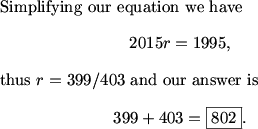
Someone (19:45:35)
802
MCrawford (19:45:47)
This problem tested our understanding of geometric series as well as our abilities to factor and substitute. It is important to recognize when we can replace some part of an expression with a nicer value.
Substitutions, geometric series, and even more complicated kinds of series summations are taught in the AoPS Intermediate Algebra class.
MCrawford (19:46:05)
Problem 4:
MCrawford (19:46:08)

MCrawford (19:46:16)
//s3.amazonaws.com/classroom.artofproblemsolving.com/Classroom/cbe6/images/lx-146556878.gif
MCrawford (19:46:26)
We have all seen divisor counting problems before, but this one is a bit more complicated. How can we approach it?
NightFlarer (19:46:26)
prime factorize each first
kky1638 (19:46:26)
2^10 * 5^10 and so on?
TechTroid (19:46:30)
prime factors
MCrawford (19:46:47)
Before we get into discussing the method we're going to use to solve this problem, it makes sense to complete the first step students are likely to complete when first encountering this problem. Find the prime factorizations of integers almost always helps us organize the information we need -- particularly in divisor counting problems.
Someone (19:46:48)
prime factorize first!
mathgeek2006 (19:46:50)
prime factorization
MCrawford (19:46:55)

MCrawford (19:47:02)
First, how many divisors does each of these integers have?
jen7 (19:47:11)
121,64,276
Mildorf (19:47:11)
Find the number of factors of each, then take two at a time, and then divisors of all three.
justdudxit (19:47:24)
121,49, and 276, respectively
soulzmischief (19:47:25)
first one: 121, second: 64, third: 276
pika (19:47:27)
121, 64, 276
MCrawford (19:47:33)
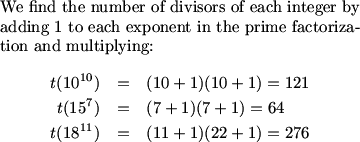
fedwinri (19:47:35)
r^a*r^b ---> (a+1)(b+1)
MCrawford (19:47:49)
Students interested in learning the mechanics behind this formula deeply enough to solve more difficult and interesting problems might consider taking the AoPS Introduction to Number Theory class.
Scrambled (19:47:47)
subtract off the overcounted ones
MCrawford (19:48:03)
Simply adding the totals for each integer together will not give us our answer because we will have overcounted divisors common to at least 2 of the 3 integers.
How can we correct for this overcounting?
Scrambled (19:46:14)
PIE it
justdudxit (19:46:17)
PIE!!!
edummit (19:46:18)
Inclusion-exclusion looks like the way to go.
pika (19:46:30)
PIE?
fedwinri (19:46:33)
Inclusion-exclusion. Draw the diagram for clarity.
JHu (19:46:35)
PIE
Mildorf (19:46:38)
Principle of inclusion exclusion.
MCrawford (19:48:26)
We could use a Venn diagram to help us organize our correction for overcounting, but students who know the principle of inclusion-exclusion (PIE) can jump straight to calculation.
What numbers are we going to subtract from the sum of the total numbers of divisors?
d343seven (19:48:45)
factors of 2 of them
dts (19:48:54)
Those that divide two of them.
pika (19:48:58)
the divisors of two of them?
fedwinri (19:49:01)
the three pairs of common factors to two of these
MCrawford (19:49:15)
We need to subtract the numbers of divisors common to each pair of integers.
Mildorf (19:49:13)

MCrawford (19:49:25)
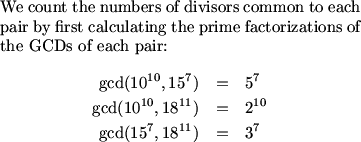
MCrawford (19:49:35)

Mildorf (19:49:32)
No prime divides all three, thus 1 is the only factor of all.
MCrawford (19:49:54)
Once we subtract out the divisors common to each pair, we will have subtracted the divisors common to all three a total of 3 times. We had only included those divisors once for each of our first three divisor counting calculations, so we'll have to add these back in so that they are included once.
MCrawford (19:49:59)
Don't worry, for those of you less familiar with PIE calculations, this will look simpler when we are done.
fedwinri (19:49:56)
Then subtract the ""1,"" which divides all.
dts (19:49:48)
Now, add 1.
MCrawford (19:50:14)
There are no prime divisors common to all three integers, so the only divisor common to all three is 1.
jen7 (19:47:42)
121+64+276-8-8-11+1=435
edummit (19:50:33)
Therefore the answer is (121+64+276) - (8+11+8) + 1, or 435.
MCrawford (19:50:37)

Mildorf (19:49:55)
Then add the numbers that divide one, subtract then number dividing two, and then add one in.
JohnGalt (19:49:22)
sorry for the stupid question, but what is PIE?
Someone (19:50:55)
Principle of inclusion exclusion
fedwinri (19:50:56)
Principle of Inclusion-Exclusion
MCrawford (19:51:32)
It's a matter of finding the number of elements of a group of overlapping sets by subtracting elements common to two, adding back for three, subtracting for four, etc.
conartist (19:51:21)
you overcount then undercoutn tehn overcount then undercount until you get your amount
pika (19:51:21)
Add the first groups together, subtract overlap, add in oversubtracted overlap, etc.
Mildorf (19:51:11)
Not a stupid question. Principle of inclusion-exclusion.
Bictor717_2 (19:50:47)
could you have solve this using LCM?
MCrawford (19:52:12)
LCM uses max(exponents), and here we needed min(exponents)
MCrawford (19:52:17)
It was helpful to understand not only the process for divisor counting, but also to understand it well enough (along with the idea of the GCD) to count the divisors common to more than one of these integers. In the end, our PIE calculation didn't look so bad. We add the counts for each, subtract the counts for two at a time, than add back the count for all three.
MCrawford (19:52:32)
The principle of inclusion-exclusion continues with alternating signs for more than 3 groups. This counting technique is discussed in detail in the Intermediate Counting & Probability class.
codeblue87 (19:52:32)
AOPS covers PIE
MCrawford (19:52:58)
Problem 5:
codeblue87 (19:52:58)
volume 2
justdudxit (19:53:00)
Its really handy
Mildorf (19:53:07)
A good application of PIE is determining the number of permutations of n objects such that none stays put.
MCrawford (19:53:19)
Problem 5:
MCrawford (19:53:20)

MCrawford (19:53:25)
//s3.amazonaws.com/classroom.artofproblemsolving.com/Classroom/cbe6/images/lx-227502030.gif
MCrawford (19:53:30)
We have a logarithmic equation and generally we don't like dealing with logarithms.
MCrawford (19:53:33)
What is interesting about the equation that might help us?
justdudxit (19:53:42)
one log is the reciprocal of the other
edummit (19:53:47)
The logarithms are reciprocals.
JohnGalt (19:53:50)
they are reciprocals
conartist (19:53:51)
recipricol logs
pika (19:53:49)
log_a(b)=1/(log_b(a))
MCrawford (19:54:01)

dts (19:53:39)

yif man12 (19:53:47)
loga(b)=x, logb(a)=1/x
JHu (19:54:09)

MCrawford (19:54:19)

edummit (19:54:26)
Quadratic with solutions x = 2 and x = 3.
fedwinri (19:54:10)
2*3=6, 2+3=5. It translates roughly to the same work as quadratic.
dts (19:54:34)
Solving for x, we get x=2 or x=3.
MCrawford (19:54:42)
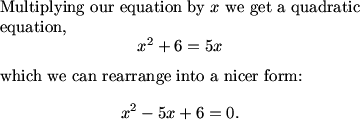
pika (19:54:40)
\multiply by x, move 5x quadratic formula!
yif man12 (19:54:42)
x^2+5x-6=0 factors to (x-2)(x-3)
MCrawford (19:54:53)

JohnGalt (19:54:57)
so we have all squares and cubes under 2005
MCrawford (19:55:13)

dts (19:55:08)
So, the task becomes finding how many squares and cubes there are less than 2005.
MCrawford (19:55:24)
Well, almost.
Mildorf (19:55:20)

MCrawford (19:55:32)
necessary), so we convert these equations to exponential form:
a2=ba3=b
one of which must be true.
justdudxit (19:55:31)
gotta exclude 1
MCrawford (19:55:45)

edummit (19:55:46)
(2, 4), (3, 9), (4,16), ... (44, 44^2 = 1936) but not 45 because 45^2 = 2025.
justdudxit (19:55:54)
43
MCrawford (19:56:06)
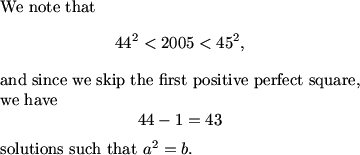
fedwinri (19:56:07)
Sqaures don't work with negative (because even powers go +). Then just find squares from 4 (because of bound, 2) to 2005.
MCrawford (19:56:28)

jen7 (19:55:22)
2 to 44 for squares and 2 to 12 for cubes
justdudxit (19:56:37)
11
jen7 (19:56:37)
11; (2,8), (3, 27)...(12, 1728)
MCrawford (19:56:58)
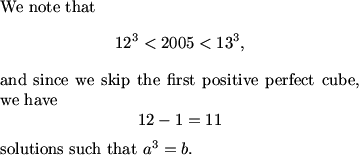
pika (19:55:43)
But some are both!
Mildorf (19:56:58)
What about numbers like 64? :)
justdudxit (19:57:22)
doesn't matter. a is different
JohnGalt (19:57:31)
but we are looking for ordered pairs, so they can be the same
edummit (19:57:32)
(4, 64) and (8,64) are distinct pairs.
codeblue87 (19:57:40)
64 you'd still have different solutions, one being (4,64) the other (8,64)
dts (19:57:41)
We don't subtract those, because b is different for the two 64 solutions for a.
fedwinri (19:57:51)
Different value for x (or whatever): (4,64) != (8,64)
Mildorf (19:57:48)

jen7 (19:57:47)
but we were asked to find the ordered pairs
MCrawford (19:58:12)

MCrawford (19:58:38)
I nearly made the mistake of applying PIE when writing up this solution.
dts (19:58:27)
I wonder how many people fell into that trap of subtracting the equal squares/cubes...
MCrawford (19:58:51)
I'm sure more than a few uncareful souls.
MCrawford (19:58:57)

TechTroid (19:58:53)
*raises hand*
MCrawford (19:59:02)
Logarithms and convenient substitutions are both taught in the AoPS Intermediate Algebra class.
MCrawford (19:59:20)
Problem 6: (my least favorite)
MCrawford (19:59:23)
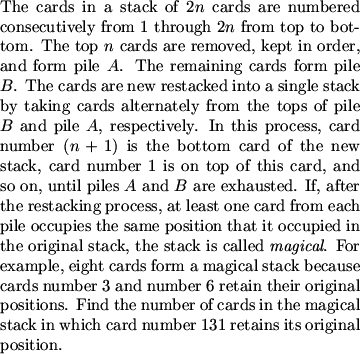
MCrawford (19:59:27)
//s3.amazonaws.com/classroom.artofproblemsolving.com/Classroom/cbe6/images/lx-15361262.gif
Mildorf (19:59:31)
Ack, a lot of reading!
MCrawford (19:59:40)
This problem takes as long to read as to discuss, so I'll give you a moment to read, digest, and then ponder how we can proceed.
codeblue87 (19:59:34)
i don't even want to read that
Someone (19:59:34)
maybe cus it's huge
conartist (19:59:39)
so long [img id=em-1] to read
MCrawford (20:00:02)
Actually, its length is only the second in my reasons for not enjoying this problem.
dts (19:59:45)
This one wasn't so bad, once you wrap your mind around it...
MCrawford (20:00:10)
What will help us with this problem?
TechTroid (19:59:50)
make a diagram
edummit (20:00:15)
Draw it...
MCrawford (20:00:24)
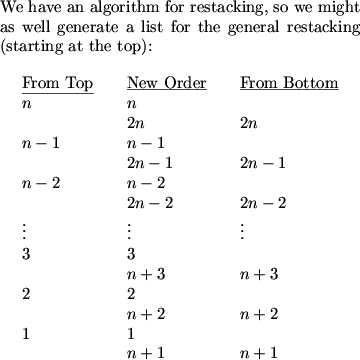
MCrawford (20:00:42)
This of course makes the problem look intimidating -- like trying to read the Matrix or something.
MCrawford (20:00:56)
Now, we are given that 131 is the 131st number from the top of this list. How does that help us?
Scrambled (20:00:59)
just take it form the top
fedwinri (20:01:00)
Take it from both ends separately. One way, only the even terms work--the other, only the odd. Then just set up sums using n and 2n, solve general on both sides. The right-hand side needs something even, so 131 is 1+2a.
edummit (20:01:10)
We just want to find where card 131 goes in terms of n, and then solve for n.
MCrawford (20:01:43)
Which stack must it have come from?
JHu (20:01:55)
A
dts (20:02:02)
A.
MCrawford (20:02:08)
Additionally, we can say that card 131 was the 66th number from the top of the restacked deck out of those that came from the top half of the original deck.
MCrawford (20:02:18)
The cards that come from the top half of the original deck are 1st, 3rd, 5th, 7th, etc. in the restacked deck. This means card 131 came from that deck.
Additionally, we can say that card 131 was the 66th number from the top of the restacked deck out of those that came from the top half of the original deck.
MCrawford (20:02:23)
What is our answer?
JHu (20:01:32)
n-65 = 131
jen7 (20:01:38)
(n-131+1)+(n-131)=131, so 2n=392
Scrambled (20:02:30)
392
justdudxit (20:02:35)
392
MCrawford (20:02:48)
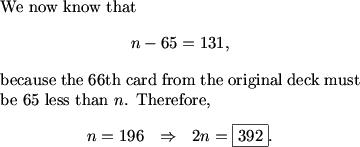
dts (20:03:03)
What was your other reason for disliking this problem?
MCrawford (20:03:23)
There wasn't much to it. So boring.
MCrawford (20:03:25)
Remember, problems with lengthy setups are typically highly engineered problems. This means that either it took a lot of words to relate a simple mathematical situation to an analogous situation or the complication in the problem is largely artificial (in which case there are clues such as in equations involving square roots or denominators).
MCrawford (20:03:42)
The key to solving this particular problem was simply modeling the ordering of the new deck in an organized way. Organization makes so much of mathematics simpler.
edummit (20:03:38)
I didn't like it either, but that's because I answered 196 instead of 392 during the exam... : )
MCrawford (20:04:01)
Problem 7: (one I liked better)
MCrawford (20:04:03)

MCrawford (20:04:08)
//s3.amazonaws.com/classroom.artofproblemsolving.com/Classroom/cbe6/images/lx-140339646.gif
MCrawford (20:04:13)
What is ugly about this problem?
Someone (20:04:18)
the denom.
Scrambled (20:04:19)
radicals
dts (20:04:23)
That hideous denominator.
mathgeek2006 (20:04:23)
The sqrts
edummit (20:04:24)
The radicals...
MCrawford (20:04:38)
The ugly parts about the problem are the radicals in the denominator.
What is interesting about this problem?
Mildorf (20:04:20)
The bottom is a geometric series.
MCrawford (20:04:57)
The radicals in the denominator are in a progression of square roots within their respective factors.
Is there some way we can use this interesting fact to deal with the ugliness of this problem?
TechTroid (20:04:50)
multiply by (16throot(5)-1) over itself, everything cancels
pika (20:04:58)
multiply the bottom by 16throot(5)-1
yif man12 (20:05:01)
use conjugates
codeblue87 (20:04:56)
the exponents form a geo. series
pika (20:05:11)
after that it collaspes :)
dts (20:05:14)
Expanding that denominator, we get a geometric series. This gave me the idea of multiplying the top and bottom by 16rt(5)-1, which makes the denominator collapse.
edummit (20:05:15)
Multiply both the numerator and denominator by (5^(1/16) - 1).
MCrawford (20:05:28)
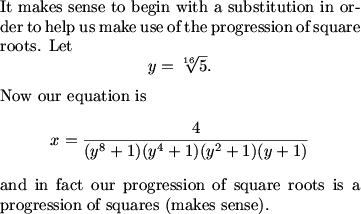
MCrawford (20:06:01)
Many of you bypassed this step, but it helps for those who haven't seen it yet.
MCrawford (20:06:03)
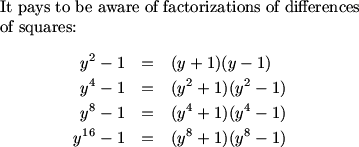
MCrawford (20:06:20)
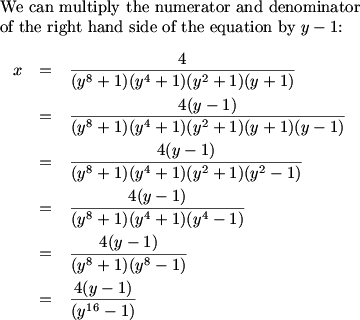
justdudxit (20:04:47)
5-1=4
Someone (20:05:51)
the bottom becomes 4
MCrawford (20:06:38)
The differences of squares wrap up to one nice expression!
MCrawford (20:06:48)

MCrawford (20:06:57)
What is our final answer?
jen7 (20:05:58)
x=5^(1/16), so (x+1)^48=5^3=125
pika (20:06:39)
now it's just (16th(5)-1+1)^48
Mildorf (20:06:44)
125.
pika (20:06:57)
which is just 5^3=125
Mildorf (20:06:58)
The 4 cancels, add one, take 48th power of 16th root of 5.
Scrambled (20:07:02)
125
jen7 (20:07:02)
125
dts (20:07:02)
125.
MCrawford (20:07:15)

conartist (20:07:11)
beautiful
Scrambled (20:07:10)
i just multiplied this whole thing out[img id=em-3]
dts (20:07:28)
I enjoyed that one.
codeblue87 (20:07:33)
harder than it looks
mathgeek2006 (20:07:38)
wonderful[img id=em-10]
codeblue87 (20:07:39)
easier than it looks*
MCrawford (20:08:04)
I'm sure that depends on your experience turning ugly expressions into nicer ones.
yif man12 (20:08:05)
i multiplied conjugates of the greatest term in the denominator each time and it worked out well
edummit (20:08:08)
I remember a problem somewhat like that from an ARML a few years back.
fedwinri (20:08:14)
(I've done the brute * on theese, too, scrambled.)
MCrawford (20:08:28)
Recognizing that we could substitute for the ugliest part of the equation gave us a much nicer expression to work with. If we did not already recognize that we could use differences of squares to simplify the our work, this become more clear after substitution.
Convenient substitutions and factorizations methods are both taught in detail in the AoPS Intermediate Algebra course.
MCrawford (20:08:47)
Here's where the test begins to get a bit harder.
MCrawford (20:08:51)
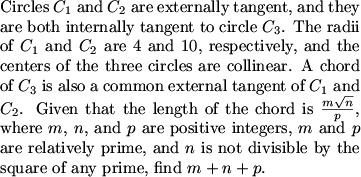
MCrawford (20:08:55)
//s3.amazonaws.com/classroom.artofproblemsolving.com/Classroom/cbe6/images/lx-138410862.gif
MCrawford (20:08:59)
What's the first thing we should do with this problem?
conartist (20:08:58)
diagram!!
MCrawford (20:09:07)
We need a diagram:
MCrawford (20:09:15)
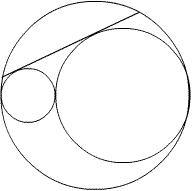
fedwinri (20:09:10)
hurray for the first picture.
MCrawford (20:09:27)
How might we work with this diagram?
Scrambled (20:09:31)
draw in the centers
Scrambled (20:09:39)
make right triangles too
dts (20:09:47)
Draw the diameter of the large circle, and radii to the tangent points.
MCrawford (20:09:57)
Whenever we have circles and tangents, it makes sense to draw lines from the centers of the circles to the points of tangency. The resulting right angles often come in handy:
MCrawford (20:10:03)
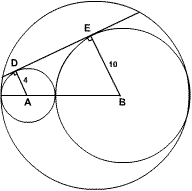
MCrawford (20:10:11)
How can we make those right angles work for us?
edummit (20:10:13)
Extend the chord to make a right triangle.
MCrawford (20:10:40)
What's nice about those triangles?
justdudxit (20:10:50)
Similar
edummit (20:10:59)
They're all similar.
fedwinri (20:10:59)
similarit
MCrawford (20:11:09)
One of the ways in which right angles often come in handy in these situations (particularly when circles are involved) is that they help us identify similar triangles:
MCrawford (20:11:14)
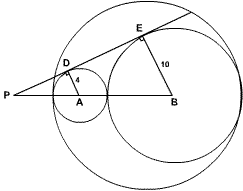
Mildorf (20:11:18)
Drop perpendicular from A to BE. It's similar to this too!
MCrawford (20:11:30)
We're not going to need it :)
MCrawford (20:11:47)
We could keep assigning lengths and even calculate a few using similar triangles, but it's important to keep our eye on the ball. Nothing in our diagram gives us an immediate route toward finding the length of the chord.
MCrawford (20:11:53)
How might we find the length of a chord within a circle?
pika (20:12:00)
POAP!
dts (20:12:04)
Ohh... Power of a Point.
MCrawford (20:12:33)
But how are we going to get nice intersecting chords (emphasis on ""nice"")?
Mildorf (20:12:27)
Determine the radius of the circle and the distance to the chord from the center.
edummit (20:12:29)
Draw the center of the large circle, and then an altitude from that center to the chord.
MCrawford (20:12:46)
We often find lengths of chords using power of a point. In particular, when we know the radius of a circle, we can often draw a useful perpendicular from the center of the circle to the chord:
MCrawford (20:12:51)
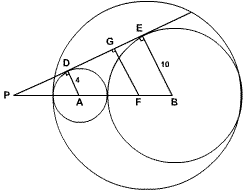
pika (20:09:38)
C3 has radius 14
MCrawford (20:13:05)
We know that the radius of the larger circle is 4 + 10 = 14 because they the three circles are so nicely arranged on an axis. If we can determine the length of the perpendicular to the chord, we will be able to apply power of a point to get our answer.
MCrawford (20:13:11)
How can we determine the length of the segment from the center of the larger circle to the chord?
dts (20:13:21)
Similar triangles.
MCrawford (20:13:29)
Anything quicker?
Mildorf (20:13:35)
We can get AF = 10 easily.
justdudxit (20:13:48)
linear-ness
edummit (20:13:54)
Weighted average.
MCrawford (20:14:02)
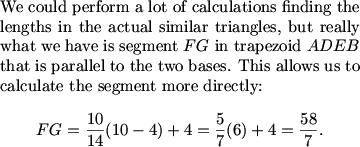
MCrawford (20:14:28)
Now, how do we apply power of a point to find our answer?
edummit (20:15:01)
You could use the Pythagorean Theorem too (it's the same calculation, really).
dts (20:15:14)
Let half the length of the chord be x, and we have x^2=(14+58/7)(14-58/7).
MCrawford (20:15:32)
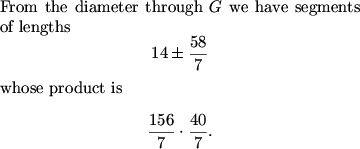
dts (20:15:28)
So we didn't even need point P.
Bictor717_2 (20:15:32)
perpendicular radius bisects the chord
MCrawford (20:15:51)
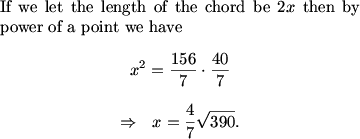
MCrawford (20:16:02)
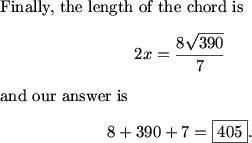
MCrawford (20:16:24)
We didn't need power of a point, but it's the more general application, so I prefer to use it.
pika (20:16:17)
that was cool
MCrawford (20:16:32)
The key to solving this problem efficiently was recognizing that we can always draw a diameter through the center of a chord creating a nice symmetry. If we know the radius and the length from the center of the circle to the chord, then power of a point helps us find the length of the chord. Of course, we also needed to drop perpendiculars from the radii to create the nice right angles that allowed us to apply similarity and find the distance from the center of the circle to the chord to begin with.
pika (20:16:47)
do these appear often?
MCrawford (20:17:02)
Power of a point problems are very common.
MCrawford (20:17:04)

dts (20:17:06)
I personally enjoyed #9...
MCrawford (20:17:14)
//s3.amazonaws.com/classroom.artofproblemsolving.com/Classroom/cbe6/images/lx-96729439.gif
MCrawford (20:17:18)
If you have experience with complex numbers and trigonometry, these expressions look both familiar and unfamiliar.
MCrawford (20:17:24)
What's different from the way in which we typically work with complex numbers using trig functions?
edummit (20:17:25)
That almost looks like DeMoivre's identity.
justdudxit (20:17:34)
The functions are reversed
pika (20:17:34)
ack, sin and cos are SWITCHED!
Bictor717_2 (20:17:34)
they're not in cis form
edummit (20:17:39)
Except sine and cosine are flipped.
MCrawford (20:17:50)
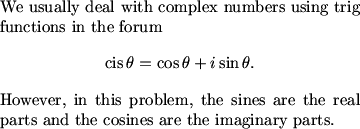
MCrawford (20:17:59)
We would like to apply a tool such as DeMoivre's Theorem. In fact, this problem is screaming ""DeMoivre"" so loudly that it's hard to maintain a dialogue with a banshee.
Mildorf (20:17:34)
DeMoivre's formula on 90-t.
dts (20:17:47)
Use the induced formulas: (sin t+ i cos t)=(cos(90-t)+i sin(90-t)).
pika (20:17:58)
sinx=cos(90-x)
MCrawford (20:18:27)

pika (20:18:22)
QUESTION: is this in degrees or radians?
MCrawford (20:18:39)
It actually doesn't matter, but I'm using radians.
MCrawford (20:18:59)

MCrawford (20:19:23)

edummit (20:19:27)
Then you can apply DeMoivre's Theorem.
Bictor717_2 (20:19:30)
Apply demoivre to the left
MCrawford (20:19:50)

MCrawford (20:20:03)

Mildorf (20:20:00)
Then use modulo 360 or 2pi.
MCrawford (20:20:13)

Bictor717_2 (20:20:13)
angles differ by multples of 2pi
MCrawford (20:20:24)

MCrawford (20:20:45)

dts (20:18:57)
Then expand using DeMoivre. It works out iff n=1 (mod 4).
justdudxit (20:20:18)
n= 1,5,..
edummit (20:20:21)
n must be congruent to 1 modulo 4.
MCrawford (20:21:05)

MCrawford (20:21:14)

MCrawford (20:21:17)
What is our final answer?
dts (20:21:28)
1000/4=250.
MCrawford (20:21:36)

edummit (20:18:30)
Couldn't you multiply by the DeMoivre equation too?
MCrawford (20:22:00)
Yes, that works out very nicely in fact.
MCrawford (20:22:14)
I didn't see that one what I wrote this up -- fairly straight forward either way.
edummit (20:22:14)
Because (cos t + i sin t) (sin t + i cos t) simplifies to i.
MCrawford (20:22:24)
Slick!
MCrawford (20:22:32)
Students interested in learning more about the relationships between complex numbers and trigonometry might consider taking the AoPS Intermediate Complex Numbers/Trigonometry class.
MCrawford (20:23:03)
Problem 10 is not all that difficult for students who know geometric solids, but let's look for a nice solution:
MCrawford (20:23:06)

MCrawford (20:23:11)
//s3.amazonaws.com/classroom.artofproblemsolving.com/Classroom/cbe6/images/lx-123229886.gif
MCrawford (20:23:16)
What is nice about the solids we are examining other than the fact that we have a good idea that we could brute force a solution out of them due to simplicity?
edummit (20:23:42)
They're regular, and symmetric.
MCrawford (20:23:59)
The nice thing about the solids that we are examining is that they have symmetries.
Is there a nice way to model this problem so as to take advantage of the symmetries?
edummit (20:24:16)
Coordinates work pretty well.
MCrawford (20:24:31)
A regular octahedron has 6 vertices that are all equally spaced around its center. This reminds us of coordinate axes, so we place the octahedron down in a 3-D coordinate space:
MCrawford (20:24:36)
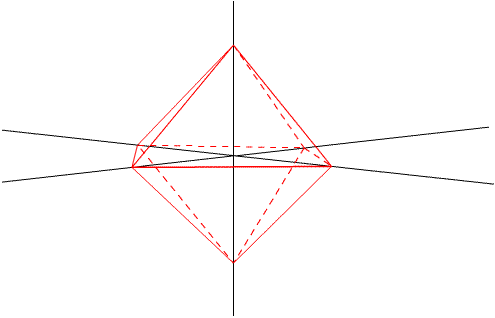
MCrawford (20:24:44)
Here is a more interactive (applet) picture that might help your visualization (this may take significant time to load on slow internet connections):
MCrawford (20:24:48)
http://mathworld.wolfram.com/Octahedron.html
MCrawford (20:24:53)
How can we take greatest advantage of this coordinate model?
Bictor717_2 (20:25:19)
the center of the face in the 1st octant is (1,1,1) and intercepts are +/-3
MCrawford (20:25:33)
We can do even better
edummit (20:25:28)
Pick values like (0,1), (1,0), (-1,0), (0, -1) for the coordinates.
MCrawford (20:25:41)
The length of the side of the octahedron makes no difference since the volume of the cube scales directly with the volume of the octahedron. Since we have carte blanche control over our model, we might as well stick to simplicity and let each of the vertices lie at points 1 unit from the origin:
MCrawford (20:25:46)

MCrawford (20:25:56)
Now, what's the volume of the octahedron?
pika (20:26:29)
what's the formula for the volume?
MCrawford (20:26:45)
We don't need a formula -- we have two square based pyramids.
Mildorf (20:26:44)
Turn it into two pyramids.
Bictor717_2 (20:26:51)
2*(1/3)*2*1
edummit (20:27:01)
The volume of the top half is (1/3)(1)(2) = 2/3, since the area of the square base is 2 and the height is 1. Similar for the bottom, so that the total volume is 4/3.
MCrawford (20:27:10)
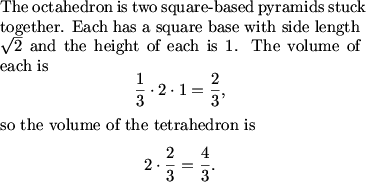
MCrawford (20:27:15)
Now, how can we find the volume of the cube?
eryaman (20:27:44)
find the coordinates of the center of the faces of the octahedron
Mildorf (20:27:50)
Centered at the origin, with a vertex at (1/3,1/3,1/3)?
edummit (20:27:51)
Find the centroids of two faces of the octahedron.
MCrawford (20:28:01)
The easiest way to find the volume of a cube is to cube the length of an edge.
MCrawford (20:28:04)
The vertices of the cube are at the centroids of the faces of the equilateral triangles that make up the octahedron.
MCrawford (20:28:13)
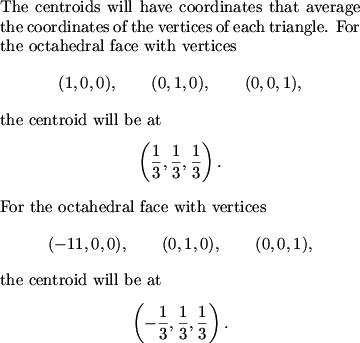
MCrawford (20:28:32)
that's a -1 where is says -11.
MCrawford (20:28:37)
What is our answer?
pika (20:28:48)
2/3=edge?
MCrawford (20:28:56)
Yes.
Mildorf (20:28:56)
Edge of 2/3, volume of 8/27.
pika (20:29:02)
8/27=cube volume
Bictor717_2 (20:29:02)
V of cube =(2/3)^3
Someone (20:29:03)
8/27
MCrawford (20:29:14)
And our answer is?
edummit (20:29:18)
Therefore the side is 2/3, so the cube's volume is 8/27. Dividing 8/27 into 4/3 yields 9/2, so the answer is 11.
Scrambled (20:29:22)
11
Mildorf (20:29:25)
(4/3) / (8/27) = 9/2
MCrawford (20:29:30)
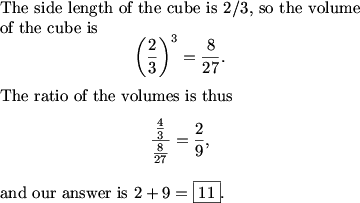
dts_2 (20:29:09)
The octahedron link you provided was cool, but it caused my computer to freeze. I fell out of the classroom.
MCrawford (20:29:38)
Sorry.
MCrawford (20:29:45)
This problem was much easier to solve for students who recognize that a regular octahedron has symmetries that allow it to be placed nicely on coordinate axes.
MCrawford (20:30:10)
Remember, finding slicker solutions often means you have more time to tackle the hardest problems on the test.
dts_2 (20:29:51)
I had solved that one anyway...
Mildorf (20:29:59)
The 3-D stuff at MathWorld has a lot of animations like that.
pika (20:30:13)
is this ratio something we should know/memorize?
MCrawford (20:30:32)
Not unless you have ample storage space.
MCrawford (20:30:45)
DPatrick will now take over for a little while.
DPatrick (20:30:54)
Problem 11:
DPatrick (20:30:59)
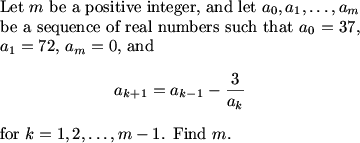
DPatrick (20:31:04)
//s3.amazonaws.com/classroom.artofproblemsolving.com/Classroom/cbe6/images/lx-221952542.gif
DPatrick (20:31:09)
How should be begin?
Scrambled (20:31:15)
do a few cases out
Mildorf (20:31:20)
List some terms?
justdudxit (20:31:22)
list a few terms
DPatrick (20:31:48)
This is a very common and good idea when presented with a recurrence: list a few cases and look for a pattern.
DPatrick (20:32:05)
In this case, though, if you do that it's gets kind of ugly pretty quickly.
edummit (20:31:23)
Multiply by a_k.
DPatrick (20:32:27)

DPatrick (20:32:35)
Now what?
DPatrick (20:32:50)
Is there a useful substitution we could make?
dts_2 (20:32:28)

Mildorf (20:32:56)

Bictor717_2 (20:33:07)
define another sequence b_k?
edummit (20:33:09)
b_k = a_k times a_(k-1).
DPatrick (20:33:22)

Bictor717_2 (20:33:37)
arithmetic progression
Scrambled (20:33:47)
bk=b(k-1)-3
dts_2 (20:33:51)

DPatrick (20:34:14)

DPatrick (20:34:25)
This is an easy recurrence to solve!
DPatrick (20:34:39)
It's an arithmetic sequence.
DPatrick (20:34:43)

DPatrick (20:35:10)

Mildorf (20:34:26)

DPatrick (20:35:30)
When will b_k reach 0?
edummit (20:35:06)
b_888 = 0.
pika (20:35:09)
b0=2664=37*72
fedwinri (20:35:31)
24*37 = 37* 72/3, no?
Mildorf (20:35:39)
888 terms later.
pika (20:35:41)
k=m=72*37/3=888
dts_2 (20:35:45)
k=888?
DPatrick (20:36:05)

DPatrick (20:36:11)
So what's the answer to the problem?
dts_2 (20:36:20)
Which translates to a_889=0.
JHu (20:36:27)
889
fedwinri (20:36:35)
888+1 because b sub k goes for a sub k+1
pika (20:36:39)
889
DPatrick (20:36:45)

Mildorf (20:36:14)
This is a nice problem!
Scrambled (20:37:05)
that was really cool!
DPatrick (20:37:10)
I think so too.
edummit (20:37:24)
Is there any other way to solve this problem?
DPatrick (20:37:59)
I don't know. This was the most natural thing to do for me: first clear the denominator, and then the substitution hopefully jumps out at you.
DPatrick (20:38:20)
Let's move on to Problem 12:
DPatrick (20:38:25)

DPatrick (20:38:32)
//s3.amazonaws.com/classroom.artofproblemsolving.com/Classroom/cbe6/images/lx-161681118.gif
edummit (20:38:39)
Diagram!
TechTroid (20:38:43)
diagram
DPatrick (20:39:08)
More specifically, how (or should I say where?) should we draw it?
kostya (20:39:23)
coordinatex
Bictor717_2 (20:39:41)
complex plane, centered at O
Singular (20:39:43)
centered at O
DPatrick (20:39:52)
There are probably several ways to approach this problem. I thought to set it up on the complex plane.
DPatrick (20:39:59)
That way I can think of E and F in terms of a rotation about the origin O by an angle of 45 degrees.
DPatrick (20:40:09)
We want to set it up to be as simple as possible, so let's make O the origin, A the point 450 + 450i, and B the point -450 + 450i, as in the following picture:
DPatrick (20:40:14)
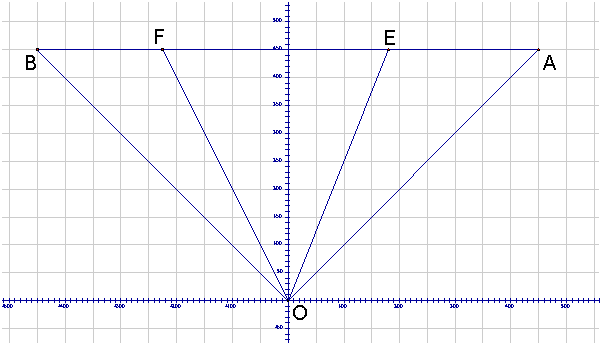
DPatrick (20:40:16)
//s3.amazonaws.com/classroom.artofproblemsolving.com/Classes/AIME/Images/2005aime2_12.gif
DPatrick (20:40:28)
Points E and F are somewhere on the segment AB.
DPatrick (20:40:37)
What else do we know in this picture?
dts_2 (20:40:53)
FOE=45 degrees.
Singular (20:40:58)
*angle FOE is 45 degrees
DPatrick (20:41:09)
We know that the angle EOF is 45 degrees.
How can be express this fact using complex numbers?
DPatrick (20:41:50)
Let me phrase my question another way...
DPatrick (20:41:53)

DPatrick (20:42:00)
Then what's F?
dts_2 (20:42:14)
(x+450i)(r cis 45).
Bictor717_2 (20:42:24)
E*(cis45)
edummit (20:42:30)

DPatrick (20:42:43)
We can express F in two ways.
DPatrick (20:42:48)
On the one hand, the distance from E to F is known to be 400, so F = (x-400)+450i.
DPatrick (20:42:59)

DPatrick (20:43:06)

DPatrick (20:43:22)
Two complex numbers are equal if and only if both their real and imaginary parts are equal. So we get two equations:
DPatrick (20:43:25)

DPatrick (20:43:33)
What's the easiest way to solve this?
dts_2 (20:43:43)
Expand and subtract.
pika (20:43:46)
solve for c in terms of x substitue
justdudxit (20:43:49)
divide the equtions
DPatrick (20:44:07)
There are lots of ways, and they're pretty much all easy!
DPatrick (20:44:14)

DPatrick (20:44:22)

DPatrick (20:44:57)

DPatrick (20:45:13)
..but I already told you that! :)
DPatrick (20:45:17)

DPatrick (20:45:39)
Given that AE < BF, which solution do we want?
Mildorf (20:45:49)
+50sqrt7
edummit (20:45:57)
The one with the positive radical.
DPatrick (20:46:08)

DPatrick (20:46:14)
So how do we wrap up the problem?
pika (20:46:37)
so F=-200+50sqrt7?
DPatrick (20:46:53)
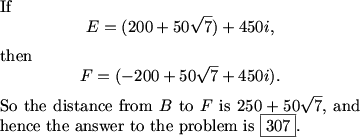
DPatrick (20:47:27)
Using complex numbers to solve geometry problems like this is a useful technique. Students can learn more about this in the AoPS Intermediate Trigonometry/Complex Numbers class.
Mildorf (20:44:15)

Mildorf (20:44:45)

DPatrick (20:47:53)
This works too I believe.
DPatrick (20:48:27)
I'm going to turn things back over to MCrawford for the last 3 problems.
MCrawford (20:48:34)
Problem 13:
MCrawford (20:48:36)

MCrawford (20:48:43)
//s3.amazonaws.com/classroom.artofproblemsolving.com/Classroom/cbe6/images/lx-154434286.gif
MCrawford (20:48:46)
What is interesting about this polynomial problem?
edummit (20:49:04)
We want integer points.
MCrawford (20:49:12)
We are working with only integers in this problem. This is an important observation as it helps guide us in our use of various tools.
MCrawford (20:49:18)
Now, what can we work with in regards to P(n)?
Mildorf (20:49:30)
Look at Q(n) = P(n)-n-3; we are told that Q(17)=-10 and Q(24)=-10
MCrawford (20:49:42)

MCrawford (20:49:49)
From where might we derive more information?
Scrambled (20:49:02)
p(24)=24-7 and p(17)=17-7
dts_2 (20:49:07)
We're given two numbers k such that P(k)=k-7.
MCrawford (20:50:08)
We know that P(17) = 10 and P(24) = 17.
MCrawford (20:50:16)
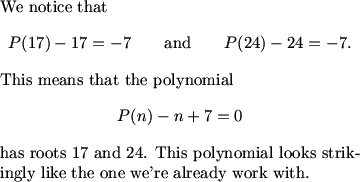
MCrawford (20:50:32)
How can we take advantage of the similarity between the two polynomials?
Mildorf (20:50:58)
Note that the change in the product corresponds to our adding the constant.
dts_2 (20:50:55)
Can we translate it down?
Singular (20:51:05)
R(n) has roots 17 and 24, so R(n) = (n-17)(n-24), find P(n).
Someone (20:51:07)
set equal?
MCrawford (20:51:31)
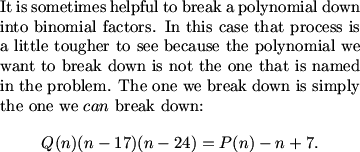
MCrawford (20:51:47)
What do we know about Q(n)?
Singular (20:52:34)
whats Q(n)?
MCrawford (20:52:44)
Some polynomial.
justdudxit (20:53:06)
It has integer coefficients
MCrawford (20:53:15)
How do we know?
justdudxit (20:53:28)
Everything else is an integer
MCrawford (20:53:41)
But we're dividing...
MCrawford (20:54:46)
How can we determine that when we divide a polynomial with integer coefficients by a binomial with lead coefficient 1 (such that there is no remainder) that we end up with a polynomial with only integer coefficients?
MCrawford (20:55:12)
What methods of division might we use?
justdudxit (20:55:16)
synthetic division?
MCrawford (20:55:28)
And what happens?
Mildorf (20:55:42)
Since leading coefficient of denominator is 1, we know we get integers.
MCrawford (20:55:49)

MCrawford (20:56:05)

MCrawford (20:56:13)
How does this help us?
pika (20:53:21)
q(n)(n-17)(n-24)=10 for some n
MCrawford (20:56:36)
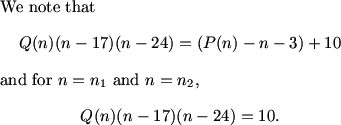
pika (20:56:35)
two n;s, actuallt
MCrawford (20:56:46)
What can we now determine?
Mildorf (20:57:13)
If Q = 1 identically, there are two such integers.
Mildorf (20:57:22)
Inspecting that -2 * -5 = 2 * 5 = 10.
MCrawford (20:57:40)
But we can be more sure of our work...
MCrawford (20:57:54)
Actually, if Q(n) = 1, there are no such integers.
Scrambled (20:57:34)
they are all factors of 10
Someone (20:57:54)
q of n = 10/(n-17)(n-24)
MCrawford (20:58:06)

Scrambled (20:58:05)
two factors are 7 off and the other one oculd be anythign
MCrawford (20:58:16)
What is our answer?
Mildorf (20:58:34)
Since 5 and -2, 2 and -5 both differ by 7, we are in luck.
pika (20:58:39)
we just want n1*n2
Singular (20:58:45)
n1 - 17, n1 - 24, we have 1,2,5,10,-1,-2,-5,-10, we need a difference of 7, only 2 and -5 or -2 and 5 work.
MCrawford (20:58:54)

Scrambled (20:58:50)
418?
MCrawford (20:59:01)

Mildorf (20:59:01)
22 and 19.
pika (20:59:05)
418
MCrawford (20:59:13)
The key to solving this problem was framing all of the given information in terms of polynomials exploiting the similarity between them by breaking the polynomial we had the most information about into factors.
MCrawford (20:59:19)
Manipulations involving polynomials with integers coefficients will be covered in the upcoming AoPS Intermediate Number Theory class.
edummit (20:59:08)
I did it differently: I said that a - b always divides P(a) - P(b) for any a and b and any polynomial P (everything in integers), so that, letting (a,b) be (n, 17) and then (n, 24) gives that n-17 divides n-7 and that n-24 divides n-14. Therefore, since (n-7)-(n-17) = (n-14)-(n-24) = 10, we can say that both n-17 and n-24 divide 10. Therefore we want all pairs of two factors of 10 that differ by 7 - {-10, -5, -2, -1, 1, 2, 5, 10} yields that n-24 can be -5 or -2, so n can be 22 or 19. Their product is 418.
MCrawford (20:59:41)
Nicely done. I think this solution is more natural actually.
Scrambled (20:59:27)
it is pure coincidence that that number is 10 higher than 17*24 right
MCrawford (21:00:04)
No -- it's a good exploration to figure out exactly why.
Mildorf (20:59:49)
Another nice problem.
MCrawford (21:00:38)
In a moment Richard Rusczyk is going to work through problem 14.
rrusczyk (21:01:07)

rrusczyk (21:01:15)
//s3.amazonaws.com/classroom.artofproblemsolving.com/Classroom/cbe6/images/lx-235400638.gif
dts_2 (21:01:21)
Draw a diagram.
Someone (21:01:27)
Diagram Please?
pika (21:01:32)
Draw a pictur
rrusczyk (21:01:55)
Let's begin with a diagram.
rrusczyk (21:02:00)
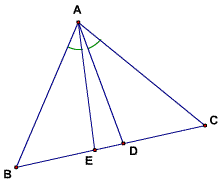
rrusczyk (21:02:02)
//s3.amazonaws.com/classroom.artofproblemsolving.com/Classes/AIME/Images/2005aime2_14.gif
rrusczyk (21:02:21)
Some of us looking at this might think to slug away at this with trig. The 13-14-15 also hints at area, since a 13-14-15 triangle has an integer area.
rrusczyk (21:02:35)
But when a geometer looks at this problem, what might the geometer think? (Besides 'Trig? Who needs trig?')
pika (21:02:37)
steward's AE
edummit (21:02:43)
Stewart's Theorem?
justdudxit (21:02:48)
Stewart
rrusczyk (21:03:25)
Is there something even more fundamental we might think about (try Stewart - you'll run into a mess pretty quickly; you can get through it, but it's scary)
rrusczyk (21:03:47)
(Those asking about Stewart's Theorem should ask on the message board for more info)
beta (21:02:52)
angle bisector?
Optimosis (21:03:38)
angle bisector?
Singular (21:03:40)
similar triangles
eryaman (21:03:42)
similar triangles?
dts_2 (21:03:43)
Try to make similar triangles out of the equal angles?
rrusczyk (21:03:57)
The equal angles suggest hunting for similar triangles. Further, the diagram brings to mind the Angle Bisector Theorem.
rrusczyk (21:04:00)

rrusczyk (21:04:14)

rrusczyk (21:04:39)
//s3.amazonaws.com/classroom.artofproblemsolving.com/Classes/AIME/Images/2005aime2_14angbis.gif
rrusczyk (21:04:42)
How do we prove this with basic geometric tools?
dts_2 (21:05:09)
Construct an auxiliary line, parallel to a given side.
Bictor717 (21:05:09)
line parallel to XW from Y or Z
rrusczyk (21:05:18)
Parallel lines -> similar triangles. We draw a line through Z parallel to XY and extend XW past W to hit the line at V. That gives us similar triangles:
rrusczyk (21:05:24)

rrusczyk (21:05:26)
//s3.amazonaws.com/classroom.artofproblemsolving.com/Classes/AIME/Images/2005aime2_14angbispro.gif
rrusczyk (21:05:32)
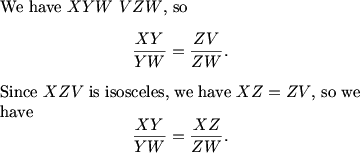
rrusczyk (21:05:44)
The Angle Bisector Theorem is discussed in all of our geometry courses, and this proof is presented in each, since it's an excellent example of judiciously using parallel lines and similar triangles. This proof, and the theorem itself, should be well-known to experienced geometers.
rrusczyk (21:05:56)
And now, back to our story.
rrusczyk (21:06:03)
Our Angle Bisector Theorem isn't immediately applicable to our problem:
rrusczyk (21:06:09)

rrusczyk (21:06:11)
//s3.amazonaws.com/classroom.artofproblemsolving.com/Classes/AIME/Images/2005aime2_14.gif
rrusczyk (21:06:15)
But, how might our thinking of it help us?
edummit (21:06:30)
Add some lines.
pika (21:06:32)
Draw line thru a || to bc?
dts_2 (21:06:39)
Draw parallels, as in the proof of the Angle Bisector Theorem?
rrusczyk (21:06:50)
Our problem looks so much like the Angle Bisector Theorem set-up that we try the same approach - drawing a parallel to AB through C and extending AD and AE to make similar triangles:
rrusczyk (21:06:59)
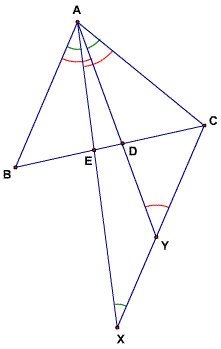
rrusczyk (21:07:00)
//s3.amazonaws.com/classroom.artofproblemsolving.com/Classes/AIME/Images/2005aime2_14ext.gif
rrusczyk (21:07:06)
All the angles marked with green arcs equal each other, and all the angles with red arcs equal each other.
rrusczyk (21:07:15)
What are we looking for here?
dts_2 (21:07:43)
Similar triangles.
rrusczyk (21:08:15)
Where are they?
Singular (21:07:40)
AXC similar to YAC
pika (21:08:23)
ABD and CDY
dts_2 (21:08:28)
CXA~CAY, for one.
Bictor717 (21:08:33)
ABE~ECX
pika (21:08:35)
ABE and ECX
rrusczyk (21:09:05)
We find three triangle similarities which might be useful. Two are pretty straightforward (ABE ~ XCE and CDY ~ BDA), but the third is a little more subtle.
rrusczyk (21:09:11)

rrusczyk (21:09:12)
//s3.amazonaws.com/classroom.artofproblemsolving.com/Classes/AIME/Images/2005aime2_14ext.gif
rrusczyk (21:09:17)
We look for the third because we need some way to use both of the angles we are given as equal. We know <CXA = <XAB from the parallel lines, and similarly, <CYA = <YAB.
rrusczyk (21:09:21)
Combining these with our given <ABE = <YAC gives us
<AXC = <CAY and <CAX = <AYC, so AXC ~ YAC.
rrusczyk (21:09:24)

rrusczyk (21:09:32)
We know lots of the lengths of sides of these triangles, namely AB = 13, AC = 14, BD = 9, CD = 6. We know we want BE.
rrusczyk (21:09:39)
Which of these similarities will give us that and how?
rrusczyk (21:10:00)
(Which will give us an equation for BE and what is this equation?)
pika (21:10:06)
ABE-XCE if we can get it
pika (21:10:30)
AB/XC=BE/CE=AE/EX
justdudxit (21:10:49)
The first
Singular (21:11:01)
abe xce.. the equation is be/ab = ce/cx ?
rrusczyk (21:11:11)
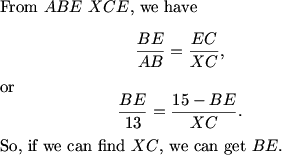
rrusczyk (21:11:21)
Where are we going to get XC and how?
pika (21:11:35)
AXC-YAC
Singular (21:11:45)
axc yac similar triangles,
pika (21:11:51)
AX/AY=CX/AC=AC/YC
justdudxit (21:11:55)
The third similarity
rrusczyk (21:12:11)
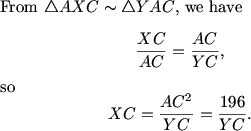
rrusczyk (21:12:23)
So if we find YC, we are home.
rrusczyk (21:12:25)
How are we going to find YC?
edummit (21:12:37)
The second similarity.
justdudxit (21:12:42)
The second similarity
pika (21:12:45)
ABD-YCD
rrusczyk (21:13:07)
What is YC?
Singular (21:13:25)
yc/ab = cd/bd = dy/da
Blaise (21:13:49)
8 2/3
Optimosis (21:13:58)
26/3
pika (21:14:00)
13/YC=9/6
rrusczyk (21:14:12)

rrusczyk (21:14:18)
So, what is XC?
pika (21:14:49)
XC=196/(26/3)
Optimosis (21:15:28)
294/13
Singular (21:15:29)
294/13
Someone (21:15:30)
294/13
edummit (21:15:31)
196 / (26/3) = 294/13.
pika (21:15:41)
294/13?
justdudxit (21:15:42)
294/13
rrusczyk (21:15:49)

rrusczyk (21:16:13)
I won't torment you with making you do the rest of the arithmetic. We can now get BE.
rrusczyk (21:16:26)
We reach for our equation for BE and find. . .
rrusczyk (21:16:28)
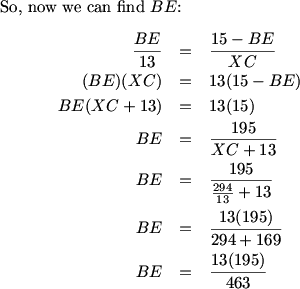
rrusczyk (21:16:43)

rrusczyk (21:16:55)
You can get here with a mountain of trig and algebra, but it won't be this pretty.
rrusczyk (21:17:31)
There's also a nice solution with the Angle Bisector Theorem and Menelaus (thanks, Mildorf).
rrusczyk (21:17:46)
(But, you have to know Menelaus, which we do cover in Olympiad Geometry).
Mildorf (21:17:22)
Nice that this can be done in many different ways.
rrusczyk (21:18:02)
Indeed - a great AIME problem.
rrusczyk (21:18:11)
And now another great AIME problem: number 15.
Singular (21:17:27)
Woooooo!!! #15!!!!
MCrawford (21:18:48)
The following was my favorite problem on either of this year's AIMEs.
MCrawford (21:18:50)
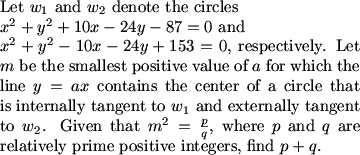
MCrawford (21:19:00)
//s3.amazonaws.com/classroom.artofproblemsolving.com/Classroom/cbe6/images/lx-32913454.gif
MCrawford (21:19:07)
This is one of my favorite problems in the history of the AIME.
First, describe the circles traced by the given equations.
edummit (21:19:16)
Put the circles in standard form.
TechTroid (21:19:26)
complete the squares
eryaman (21:19:27)
complete the square?
Mildorf (21:19:29)
Use complete the square to find centers and radii.
MCrawford (21:19:39)
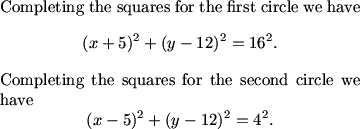
MCrawford (21:19:44)
The first circle has radius 16 and is centered at (-5, 12).
The second circle has radius 4 and is centered at (5, 12).
MCrawford (21:19:55)
It makes sense to do a bit of graphing to get a visual grip on what's going on:
MCrawford (21:20:01)
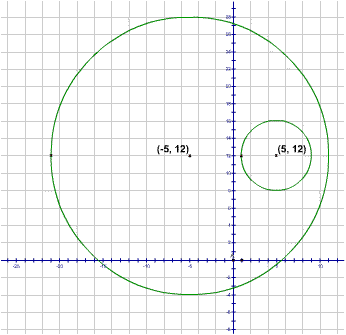
MCrawford (21:20:07)
Our goal is to find the smallest positive slope of a line that passes through both the origin and the center of a circle ""between"" the two circles we plotted.
Where can we go from here?
dts_2 (21:19:45)
I'm pretty sure the locus of all possible centers of the desired circles is an ellipse, whose foci are the centers of the given circles...
MCrawford (21:20:24)
We have a conjecture!
Mildorf (21:20:29)
Yes, consider the points and tangency.
MCrawford (21:20:49)
It makes sense to take a look at some circles tangent to the first two in the way described:
MCrawford (21:20:54)
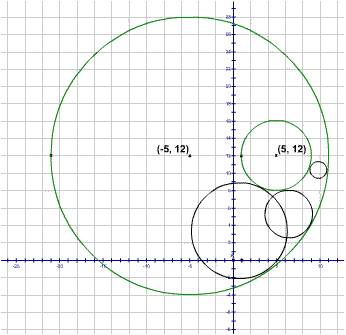
MCrawford (21:21:07)
We are interested in the locus of the centers of the circles.
MCrawford (21:21:12)
It is important to identify locus problems as the identification helps guide us in our investigation.
Mildorf (21:20:43)
It's clear that the radius of the third circle cancels out.
beta (21:20:57)
Sum of their distance is constant
beta (21:21:06)
from the centers of the two circles
MCrawford (21:21:26)
We use the definition of the constructions of the circles:
MCrawford (21:21:33)
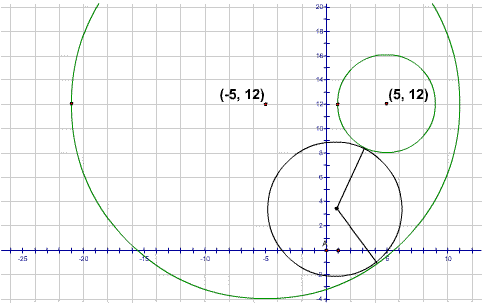
edummit (21:21:24)
The locus of points of the center of the third circle is an ellipse with foci at the centers of the two given circles, and major axis length equal to the difference of the radii of the two given circles.
Mildorf (21:21:31)
It becomes an ellipse with the two centers as foci.
dts_2 (21:21:31)
We can quickly see that the sum of the distances is constant...
MCrawford (21:21:52)
Here we draw the two radii that really define each of the ""in between"" circles -- equal distances from each of the circles -- one from the interior and one from the exterior of the original circles.
MCrawford (21:22:08)
Extending these radii through the centers of the original circles gives us a clearer picture as to what is going on in our construction:
MCrawford (21:22:17)
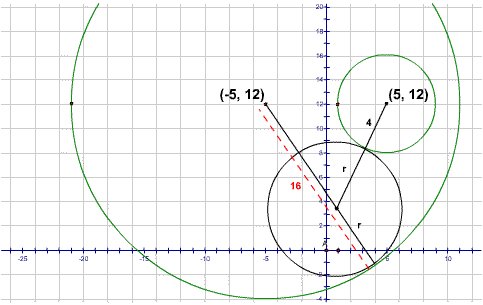
MCrawford (21:22:39)
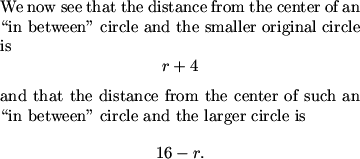
MCrawford (21:22:55)

dts_2 (21:22:54)
So, distance to one center is 16-r, distance to the other is 4+r, so, by definition, it must lie on an ellipse.
MCrawford (21:23:02)
We finally determine that the locus of the centers of the ""in between"" circles is an ellipse with foci at the centers of the original circles.
MCrawford (21:23:09)
Now that we have made this spectacular discovery, what do we need to do?
Singular (21:23:17)
find eqn of ellipse, line tangent to it
dts_2 (21:23:19)
Find the equation of the ellipse.
MCrawford (21:23:31)
We need to find the equation of the ellipse so that we can relate it to the graph of the line.
MCrawford (21:23:44)
There are several ways to find the equation of the ellipse.
MCrawford (21:23:49)
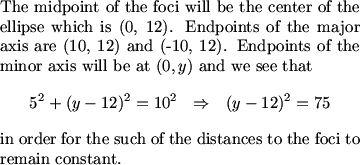
Mildorf (21:23:31)
Since we are looking for the line of minimum slope intersecting this ellipse, it is tangent.
justdudxit (21:22:54)
subsititute y=ax in the equation of the ellipse. You're home
Mildorf (21:23:56)
We might substitute y = ax so that the ellipse has a repeated root.
MCrawford (21:24:14)
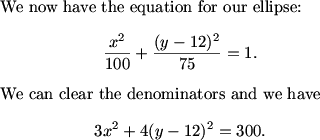
MCrawford (21:24:32)
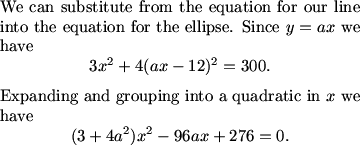
MCrawford (21:24:37)
How can we determine the smallest positive value for a?
Singular (21:24:47)
discrim 0
edummit (21:24:49)
Look at the discriminant of the quadratic.
dts_2 (21:24:50)
Set the discriminant equal to 0.
Mildorf (21:24:52)
By the tangency, this has two equal roots x.
TechTroid (21:24:58)
discriminant
MCrawford (21:25:19)
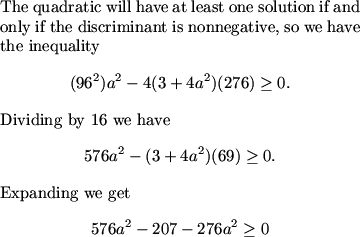
MCrawford (21:25:31)
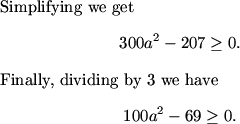
MCrawford (21:25:36)
What is our answer?
dts_2 (21:25:41)
169.
Mildorf (21:25:44)
69/100 => 169
pika (21:25:47)
a=sqrt(69)/10?
edummit (21:25:49)
169.
justdudxit (21:25:49)
169
MCrawford (21:25:59)
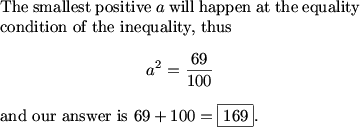
MCrawford (21:26:12)
Let's review what we did to solve this problem.
MCrawford (21:26:16)
We plotted the circles and discovered that we had a locus problem on our hands. It is extremely important to recognize that constructions of geometric graphs often relate to their definitions as loci of points.
MCrawford (21:26:30)
We determined the locus by relating the centers of the ""in between"" circles to the centers of the original circles. This extension of our diagram was natural given that distances between tangent circles relate directly to distances between their centers and their radii because the centers and points of tangency always lie on lines together. Finally we graphed the ellipse and substituted the equation of the line to give us a quadratic. We needed ""a"" such that the solutions were real, so we looked to the discriminant to get our answer.
MCrawford (21:26:35)
Here is a pitfall to avoid:
MCrawford (21:26:50)
Some students mentioned here they assumed that the locus was a circle.
MCrawford (21:27:12)
I thought so too for about 10 seconds...until I drew things out and looked for the reasoning behind the locus.
MCrawford (21:27:40)
Then it become clear that the internally versus externally tangencies made the distances have a constant sum.
TechTroid (21:27:17)
This is why we shouldn't assume things.
2005 Alternate AIME Math Jam
Before we get started I would like to take a moment to explain our virtual classroom to those who have not previously participated in a Math Jam or one of our online classes.
MCrawford (19:29:36)
The classroom is moderated meaning that students can type into the classroom, but only the moderators can choose a comment to drop into the classroom. This helps keep the class organized and on track. This also means that only well-written comments will be dropped into the classroom, so please take time writing responses that are complete and easy to read.
MCrawford (19:29:45)
Also, only moderators can enter into private chats with other people in the classroom. You can copy the contents of a private chat by clicking on the notebook icon on the private chat window and copying and pasting the contents into a file on your own computer.
MCrawford (19:29:56)
Finally, the virtual classroom is TeX enabled. TeX allows users to make nice equations and other math expressions. If you would like to learn how to write in TeX/LaTeX, click on the tab on the left side panel of our site and there is a tutorial and reference guide there.
MCrawford (19:30:01)
Using TeX in the virtual classroom is slightly different than using it on the message board or in a TeX editor. If anything you type up in a post that uses TeX then you must use a semicolon (;) to begin your post. For example, if you type
MCrawford (19:30:05)

MCrawford (19:30:08)
This message will look like this when posted in the classroom:
MCrawford (19:30:12)

MCrawford (19:30:17)
Just remember, if your post uses TeX, use the semicolon (;) to begin your post!
MCrawford (19:30:30)
Problem 1:
MCrawford (19:30:32)

MCrawford (19:30:37)
//s3.amazonaws.com/classroom.artofproblemsolving.com/Classroom/cbe6/images/lx-57718334.gif
MCrawford (19:30:41)
How can we approach this problem?
kky1638 (19:30:43)
use combination I guess
edummit (19:30:50)
combinations
codeblue87 (19:30:56)
combinations
MCrawford (19:31:04)
It seems that we first need expressions for the numbers of ways in which we can select 3 and 6 cards from the deck.
MCrawford (19:31:08)

justdudxit (19:30:57)
set up an equation
jen7 (19:30:59)
C(n,6)=6C(n,3)
dts (19:31:14)

MCrawford (19:31:24)

justdudxit (19:31:20)
How'd you do that in Tex
MCrawford (19:31:33)
\binom{n}{6}
MCrawford (19:31:40)
How can we approach this equation?
fedwinri (19:31:44)
Write it out
codeblue87 (19:31:48)
cancel factorials
kky1638 (19:31:50)
simplify?
TechTroid (19:31:55)
use facorials
Mildorf (19:31:57)

MCrawford (19:32:07)

MCrawford (19:32:21)
Now what?
Someone (19:32:24)
simplify numerical coefficients
kky1638 (19:32:26)
get rid of n factorial on the top!
dts (19:32:29)
Cancel stuff out.
MCrawford (19:32:36)

MCrawford (19:32:39)

MCrawford (19:32:45)

edummit (19:32:34)
Cancel factors
codeblue87 (19:32:35)
expand the factorial expressions
MCrawford (19:33:01)

MCrawford (19:33:15)

Mildorf (19:32:53)

MCrawford (19:33:26)
We could go about solving a cubic equation, but at this point we recognize that 720 must be the product of 3 consecutive integers that relate to our answer. What is n?
justdudxit (19:33:35)
720 = 8*9*10. n=013
kky1638 (19:33:43)
13
edummit (19:33:44)
720 is 10 times 9 times 8, so n is 13.
MCrawford (19:33:49)

Mildorf (19:33:42)
Excuse my typo. (That should actually be 6 * 6 * 5 * 4)
MCrawford (19:33:59)
This problem tested our understanding of combinations and how they are defined in terms of the algebra. We also saw the principle of equating two same quantities, a common theme in algebraic problem solving.
dts (19:33:55)
*sigh*, at this point, I used the rational roots theorem...
MCrawford (19:34:09)
Combinations are discussed in detail in the AoPS Introduction to Counting & Probability class.
MCrawford (19:34:33)
What dts did is what might be described as, ""killing a housefly with a bazooka.""
MCrawford (19:34:42)
Problem 2:
MCrawford (19:34:44)

MCrawford (19:34:51)
//s3.amazonaws.com/classroom.artofproblemsolving.com/Classroom/cbe6/images/lx-69173438.gif
MCrawford (19:34:56)
Here we have a counting probability problem. How can we approach it?
justdudxit (19:35:06)
Good orders/All orders
fedwinri (19:35:23)
Casework almost works best since we only need to consider the first 6 choices.
edummit (19:35:26)
Look at conditional probabilities: first guest 1, then guest 2, then guest 3. Then multiply.
yif man12 (19:35:27)
get probability that the first person gets the right stuff
MCrawford (19:35:42)
If we focus on the rolls received by each guest, we can work this problem as an independent probability problem.
MCrawford (19:35:48)
What is the probability that the first guest receives rolls of all three types?
yif man12 (19:36:12)
9/28
jen7 (19:36:13)
9*6*3/9*8*7
TechTroid (19:36:21)
9/9 * 6/8 * 3/7
MCrawford (19:36:35)

edummit (19:36:43)
The first roll can be anything; the second roll can be any of the other 6 (of 8 total); the third can be 3 of the remaining 7. Thus (3/4) times (3/7).
MCrawford (19:36:57)
What is the probability that the second guest receives rolls of all three types given that the first guest did?
TechTroid (19:37:18)
6/6*4/5*2/4
edummit (19:37:47)
The first roll can be anything (again); the second roll can be any of the other 4 (of 5 total); the third can be any of the other 2 (of 4 total). Thus (4/5) times (1/2), or 2/5.
pika (19:38:05)
1*4/5*2/4
fedwinri (19:38:07)
(6/6)*(4/5)*(2/4) = 2/5
Someone (19:38:03)
2/5
MCrawford (19:38:18)

MCrawford (19:38:29)
Now what?
MCrawford (19:38:43)
What about the third guest?
Someone (19:38:39)
third prob is 1
jen7 (19:38:46)
probability 3rd guest gets different is 1
edummit (19:38:46)
The third guest always ends up with the last 3 rolls, so the probability there is 1.
TechTroid (19:38:48)
third is 1
MCrawford (19:38:59)
If the first two guests each have rolls of all three types, there is one of each type left for the third guest as well.
What is our answer?
TechTroid (19:38:39)
multiply
fedwinri (19:38:49)
The third is good to go--- multiply those two together.
edummit (19:39:08)
7/90.
Someone (19:39:16)
9/70
pika (19:39:21)
2/5*9/28
edummit (19:39:23)
9/70...
fedwinri (19:39:27)

MCrawford (19:39:38)

justdudxit (19:39:16)

NightFlarer (19:39:52)
couldn't you also just do (27*8)/(C(9,3)*C(6,3))?
MCrawford (19:40:24)
Yes, we could do that too. It all amounts to the same thing.
dts (19:40:14)
I did it that way, but botched a calculation somewhere.
MCrawford (19:40:43)
That's part of the reason I break problems down into parts -- it's easier to identify mistakes sometimes.
MCrawford (19:41:01)
And when checking your answers, it's good to check using a distinct method.
MCrawford (19:41:07)
You'll catch more errors that way.
MCrawford (19:41:18)
The key to this problem was recognizing that we could focus on one guest at a time and that the circumstances for each calculation were independent by our selection process.
Independent probability is discussed in detail in the AoPS Introduction to Counting & Probability class.
edummit (19:41:17)
I originally did it the second way during the test, and then checked it using the first method.
MCrawford (19:41:30)
Problem 3:
MCrawford (19:41:31)

MCrawford (19:41:39)
//s3.amazonaws.com/classroom.artofproblemsolving.com/Classroom/cbe6/images/lx-194431198.gif
MCrawford (19:41:47)
How can we start with this problem?
dts (19:41:49)
Let the first term be a, and the common ratio be r.
kky1638 (19:41:51)
let a be the first term and k be the ratio?
MCrawford (19:42:05)
We need to translate this problem from words into the language of mathematics.
MCrawford (19:42:10)

MCrawford (19:42:21)

TechTroid (19:41:49)
formula for a geometric series
jen7 (19:41:50)

conartist (19:41:51)
sum of infinite geomtric series is a / 1-r
yif man12 (19:42:03)
infinite series sum is t1/(1-r)
Mildorf (19:42:22)

yif man12 (19:42:41)
a/(1-r)=2005 and (a^2)/(1-r^2)=20050
JHu (19:42:52)

Mildorf (19:42:54)

MCrawford (19:43:00)

MCrawford (19:43:08)
Notice that I keep the product of 10 and 2005 factored. This often makes for easier calculation.
kky1638 (19:42:41)
take out a from both equations!
and find the common factor!
Mildorf (19:42:58)
Factor both.
MCrawford (19:43:26)

yif man12 (19:43:37)
a=2005(1-r) and then square to get a^2=2005*2005*(1-r)*(1-r)
Mildorf (19:43:38)

conartist (19:43:44)
a/(1+r) = 10
TechTroid (19:43:47)
substitute + divide
MCrawford (19:43:54)

MCrawford (19:44:13)

kky1638 (19:44:08)
a = 10 + 10r
Someone (19:44:13)
you now have simul. eq.
MCrawford (19:44:29)

justdudxit (19:44:10)
you could just divide one equation by the other and bypass a entirely...
edummit (19:44:33)
Then solve the other equation for a.
MCrawford (19:44:55)
I guess mine wasn't the fastest solution. Oh well.
MCrawford (19:44:57)

MCrawford (19:45:11)
What is our answer?
jen7 (19:45:05)

fedwinri (19:45:18)
802
kky1638 (19:45:19)
802
d343seven (19:45:20)
802
dts (19:45:23)
399/403.
soulzmischief (19:45:28)
399/403, m+n = 802
justdudxit (19:45:31)
r= 399/403 => 802
MCrawford (19:45:36)

Someone (19:45:35)
802
MCrawford (19:45:47)
This problem tested our understanding of geometric series as well as our abilities to factor and substitute. It is important to recognize when we can replace some part of an expression with a nicer value.
Substitutions, geometric series, and even more complicated kinds of series summations are taught in the AoPS Intermediate Algebra class.
MCrawford (19:46:05)
Problem 4:
MCrawford (19:46:08)

MCrawford (19:46:16)
//s3.amazonaws.com/classroom.artofproblemsolving.com/Classroom/cbe6/images/lx-146556878.gif
MCrawford (19:46:26)
We have all seen divisor counting problems before, but this one is a bit more complicated. How can we approach it?
NightFlarer (19:46:26)
prime factorize each first
kky1638 (19:46:26)
2^10 * 5^10 and so on?
TechTroid (19:46:30)
prime factors
MCrawford (19:46:47)
Before we get into discussing the method we're going to use to solve this problem, it makes sense to complete the first step students are likely to complete when first encountering this problem. Find the prime factorizations of integers almost always helps us organize the information we need -- particularly in divisor counting problems.
Someone (19:46:48)
prime factorize first!
mathgeek2006 (19:46:50)
prime factorization
MCrawford (19:46:55)

MCrawford (19:47:02)
First, how many divisors does each of these integers have?
jen7 (19:47:11)
121,64,276
Mildorf (19:47:11)
Find the number of factors of each, then take two at a time, and then divisors of all three.
justdudxit (19:47:24)
121,49, and 276, respectively
soulzmischief (19:47:25)
first one: 121, second: 64, third: 276
pika (19:47:27)
121, 64, 276
MCrawford (19:47:33)

fedwinri (19:47:35)
r^a*r^b ---> (a+1)(b+1)
MCrawford (19:47:49)
Students interested in learning the mechanics behind this formula deeply enough to solve more difficult and interesting problems might consider taking the AoPS Introduction to Number Theory class.
Scrambled (19:47:47)
subtract off the overcounted ones
MCrawford (19:48:03)
Simply adding the totals for each integer together will not give us our answer because we will have overcounted divisors common to at least 2 of the 3 integers.
How can we correct for this overcounting?
Scrambled (19:46:14)
PIE it
justdudxit (19:46:17)
PIE!!!
edummit (19:46:18)
Inclusion-exclusion looks like the way to go.
pika (19:46:30)
PIE?
fedwinri (19:46:33)
Inclusion-exclusion. Draw the diagram for clarity.
JHu (19:46:35)
PIE
Mildorf (19:46:38)
Principle of inclusion exclusion.
MCrawford (19:48:26)
We could use a Venn diagram to help us organize our correction for overcounting, but students who know the principle of inclusion-exclusion (PIE) can jump straight to calculation.
What numbers are we going to subtract from the sum of the total numbers of divisors?
d343seven (19:48:45)
factors of 2 of them
dts (19:48:54)
Those that divide two of them.
pika (19:48:58)
the divisors of two of them?
fedwinri (19:49:01)
the three pairs of common factors to two of these
MCrawford (19:49:15)
We need to subtract the numbers of divisors common to each pair of integers.
Mildorf (19:49:13)

MCrawford (19:49:25)

MCrawford (19:49:35)

Mildorf (19:49:32)
No prime divides all three, thus 1 is the only factor of all.
MCrawford (19:49:54)
Once we subtract out the divisors common to each pair, we will have subtracted the divisors common to all three a total of 3 times. We had only included those divisors once for each of our first three divisor counting calculations, so we'll have to add these back in so that they are included once.
MCrawford (19:49:59)
Don't worry, for those of you less familiar with PIE calculations, this will look simpler when we are done.
fedwinri (19:49:56)
Then subtract the ""1,"" which divides all.
dts (19:49:48)
Now, add 1.
MCrawford (19:50:14)
There are no prime divisors common to all three integers, so the only divisor common to all three is 1.
jen7 (19:47:42)
121+64+276-8-8-11+1=435
edummit (19:50:33)
Therefore the answer is (121+64+276) - (8+11+8) + 1, or 435.
MCrawford (19:50:37)

Mildorf (19:49:55)
Then add the numbers that divide one, subtract then number dividing two, and then add one in.
JohnGalt (19:49:22)
sorry for the stupid question, but what is PIE?
Someone (19:50:55)
Principle of inclusion exclusion
fedwinri (19:50:56)
Principle of Inclusion-Exclusion
MCrawford (19:51:32)
It's a matter of finding the number of elements of a group of overlapping sets by subtracting elements common to two, adding back for three, subtracting for four, etc.
conartist (19:51:21)
you overcount then undercoutn tehn overcount then undercount until you get your amount
pika (19:51:21)
Add the first groups together, subtract overlap, add in oversubtracted overlap, etc.
Mildorf (19:51:11)
Not a stupid question. Principle of inclusion-exclusion.
Bictor717_2 (19:50:47)
could you have solve this using LCM?
MCrawford (19:52:12)
LCM uses max(exponents), and here we needed min(exponents)
MCrawford (19:52:17)
It was helpful to understand not only the process for divisor counting, but also to understand it well enough (along with the idea of the GCD) to count the divisors common to more than one of these integers. In the end, our PIE calculation didn't look so bad. We add the counts for each, subtract the counts for two at a time, than add back the count for all three.
MCrawford (19:52:32)
The principle of inclusion-exclusion continues with alternating signs for more than 3 groups. This counting technique is discussed in detail in the Intermediate Counting & Probability class.
codeblue87 (19:52:32)
AOPS covers PIE
MCrawford (19:52:58)
Problem 5:
codeblue87 (19:52:58)
volume 2
justdudxit (19:53:00)
Its really handy
Mildorf (19:53:07)
A good application of PIE is determining the number of permutations of n objects such that none stays put.
MCrawford (19:53:19)
Problem 5:
MCrawford (19:53:20)

MCrawford (19:53:25)
//s3.amazonaws.com/classroom.artofproblemsolving.com/Classroom/cbe6/images/lx-227502030.gif
MCrawford (19:53:30)
We have a logarithmic equation and generally we don't like dealing with logarithms.
MCrawford (19:53:33)
What is interesting about the equation that might help us?
justdudxit (19:53:42)
one log is the reciprocal of the other
edummit (19:53:47)
The logarithms are reciprocals.
JohnGalt (19:53:50)
they are reciprocals
conartist (19:53:51)
recipricol logs
pika (19:53:49)
log_a(b)=1/(log_b(a))
MCrawford (19:54:01)

dts (19:53:39)

yif man12 (19:53:47)
loga(b)=x, logb(a)=1/x
JHu (19:54:09)

MCrawford (19:54:19)

edummit (19:54:26)
Quadratic with solutions x = 2 and x = 3.
fedwinri (19:54:10)
2*3=6, 2+3=5. It translates roughly to the same work as quadratic.
dts (19:54:34)
Solving for x, we get x=2 or x=3.
MCrawford (19:54:42)

pika (19:54:40)
\multiply by x, move 5x quadratic formula!
yif man12 (19:54:42)
x^2+5x-6=0 factors to (x-2)(x-3)
MCrawford (19:54:53)

JohnGalt (19:54:57)
so we have all squares and cubes under 2005
MCrawford (19:55:13)

dts (19:55:08)
So, the task becomes finding how many squares and cubes there are less than 2005.
MCrawford (19:55:24)
Well, almost.
Mildorf (19:55:20)

MCrawford (19:55:32)
necessary), so we convert these equations to exponential form:
a2=ba3=b
one of which must be true.
justdudxit (19:55:31)
gotta exclude 1
MCrawford (19:55:45)

edummit (19:55:46)
(2, 4), (3, 9), (4,16), ... (44, 44^2 = 1936) but not 45 because 45^2 = 2025.
justdudxit (19:55:54)
43
MCrawford (19:56:06)

fedwinri (19:56:07)
Sqaures don't work with negative (because even powers go +). Then just find squares from 4 (because of bound, 2) to 2005.
MCrawford (19:56:28)

jen7 (19:55:22)
2 to 44 for squares and 2 to 12 for cubes
justdudxit (19:56:37)
11
jen7 (19:56:37)
11; (2,8), (3, 27)...(12, 1728)
MCrawford (19:56:58)

pika (19:55:43)
But some are both!
Mildorf (19:56:58)
What about numbers like 64? :)
justdudxit (19:57:22)
doesn't matter. a is different
JohnGalt (19:57:31)
but we are looking for ordered pairs, so they can be the same
edummit (19:57:32)
(4, 64) and (8,64) are distinct pairs.
codeblue87 (19:57:40)
64 you'd still have different solutions, one being (4,64) the other (8,64)
dts (19:57:41)
We don't subtract those, because b is different for the two 64 solutions for a.
fedwinri (19:57:51)
Different value for x (or whatever): (4,64) != (8,64)
Mildorf (19:57:48)

jen7 (19:57:47)
but we were asked to find the ordered pairs
MCrawford (19:58:12)

MCrawford (19:58:38)
I nearly made the mistake of applying PIE when writing up this solution.
dts (19:58:27)
I wonder how many people fell into that trap of subtracting the equal squares/cubes...
MCrawford (19:58:51)
I'm sure more than a few uncareful souls.
MCrawford (19:58:57)

TechTroid (19:58:53)
*raises hand*
MCrawford (19:59:02)
Logarithms and convenient substitutions are both taught in the AoPS Intermediate Algebra class.
MCrawford (19:59:20)
Problem 6: (my least favorite)
MCrawford (19:59:23)

MCrawford (19:59:27)
//s3.amazonaws.com/classroom.artofproblemsolving.com/Classroom/cbe6/images/lx-15361262.gif
Mildorf (19:59:31)
Ack, a lot of reading!
MCrawford (19:59:40)
This problem takes as long to read as to discuss, so I'll give you a moment to read, digest, and then ponder how we can proceed.
codeblue87 (19:59:34)
i don't even want to read that
Someone (19:59:34)
maybe cus it's huge
conartist (19:59:39)
so long [img id=em-1] to read
MCrawford (20:00:02)
Actually, its length is only the second in my reasons for not enjoying this problem.
dts (19:59:45)
This one wasn't so bad, once you wrap your mind around it...
MCrawford (20:00:10)
What will help us with this problem?
TechTroid (19:59:50)
make a diagram
edummit (20:00:15)
Draw it...
MCrawford (20:00:24)

MCrawford (20:00:42)
This of course makes the problem look intimidating -- like trying to read the Matrix or something.
MCrawford (20:00:56)
Now, we are given that 131 is the 131st number from the top of this list. How does that help us?
Scrambled (20:00:59)
just take it form the top
fedwinri (20:01:00)
Take it from both ends separately. One way, only the even terms work--the other, only the odd. Then just set up sums using n and 2n, solve general on both sides. The right-hand side needs something even, so 131 is 1+2a.
edummit (20:01:10)
We just want to find where card 131 goes in terms of n, and then solve for n.
MCrawford (20:01:43)
Which stack must it have come from?
JHu (20:01:55)
A
dts (20:02:02)
A.
MCrawford (20:02:08)
Additionally, we can say that card 131 was the 66th number from the top of the restacked deck out of those that came from the top half of the original deck.
MCrawford (20:02:18)
The cards that come from the top half of the original deck are 1st, 3rd, 5th, 7th, etc. in the restacked deck. This means card 131 came from that deck.
Additionally, we can say that card 131 was the 66th number from the top of the restacked deck out of those that came from the top half of the original deck.
MCrawford (20:02:23)
What is our answer?
JHu (20:01:32)
n-65 = 131
jen7 (20:01:38)
(n-131+1)+(n-131)=131, so 2n=392
Scrambled (20:02:30)
392
justdudxit (20:02:35)
392
MCrawford (20:02:48)

dts (20:03:03)
What was your other reason for disliking this problem?
MCrawford (20:03:23)
There wasn't much to it. So boring.
MCrawford (20:03:25)
Remember, problems with lengthy setups are typically highly engineered problems. This means that either it took a lot of words to relate a simple mathematical situation to an analogous situation or the complication in the problem is largely artificial (in which case there are clues such as in equations involving square roots or denominators).
MCrawford (20:03:42)
The key to solving this particular problem was simply modeling the ordering of the new deck in an organized way. Organization makes so much of mathematics simpler.
edummit (20:03:38)
I didn't like it either, but that's because I answered 196 instead of 392 during the exam... : )
MCrawford (20:04:01)
Problem 7: (one I liked better)
MCrawford (20:04:03)

MCrawford (20:04:08)
//s3.amazonaws.com/classroom.artofproblemsolving.com/Classroom/cbe6/images/lx-140339646.gif
MCrawford (20:04:13)
What is ugly about this problem?
Someone (20:04:18)
the denom.
Scrambled (20:04:19)
radicals
dts (20:04:23)
That hideous denominator.
mathgeek2006 (20:04:23)
The sqrts
edummit (20:04:24)
The radicals...
MCrawford (20:04:38)
The ugly parts about the problem are the radicals in the denominator.
What is interesting about this problem?
Mildorf (20:04:20)
The bottom is a geometric series.
MCrawford (20:04:57)
The radicals in the denominator are in a progression of square roots within their respective factors.
Is there some way we can use this interesting fact to deal with the ugliness of this problem?
TechTroid (20:04:50)
multiply by (16throot(5)-1) over itself, everything cancels
pika (20:04:58)
multiply the bottom by 16throot(5)-1
yif man12 (20:05:01)
use conjugates
codeblue87 (20:04:56)
the exponents form a geo. series
pika (20:05:11)
after that it collaspes :)
dts (20:05:14)
Expanding that denominator, we get a geometric series. This gave me the idea of multiplying the top and bottom by 16rt(5)-1, which makes the denominator collapse.
edummit (20:05:15)
Multiply both the numerator and denominator by (5^(1/16) - 1).
MCrawford (20:05:28)

MCrawford (20:06:01)
Many of you bypassed this step, but it helps for those who haven't seen it yet.
MCrawford (20:06:03)

MCrawford (20:06:20)

justdudxit (20:04:47)
5-1=4
Someone (20:05:51)
the bottom becomes 4
MCrawford (20:06:38)
The differences of squares wrap up to one nice expression!
MCrawford (20:06:48)

MCrawford (20:06:57)
What is our final answer?
jen7 (20:05:58)
x=5^(1/16), so (x+1)^48=5^3=125
pika (20:06:39)
now it's just (16th(5)-1+1)^48
Mildorf (20:06:44)
125.
pika (20:06:57)
which is just 5^3=125
Mildorf (20:06:58)
The 4 cancels, add one, take 48th power of 16th root of 5.
Scrambled (20:07:02)
125
jen7 (20:07:02)
125
dts (20:07:02)
125.
MCrawford (20:07:15)

conartist (20:07:11)
beautiful
Scrambled (20:07:10)
i just multiplied this whole thing out[img id=em-3]
dts (20:07:28)
I enjoyed that one.
codeblue87 (20:07:33)
harder than it looks
mathgeek2006 (20:07:38)
wonderful[img id=em-10]
codeblue87 (20:07:39)
easier than it looks*
MCrawford (20:08:04)
I'm sure that depends on your experience turning ugly expressions into nicer ones.
yif man12 (20:08:05)
i multiplied conjugates of the greatest term in the denominator each time and it worked out well
edummit (20:08:08)
I remember a problem somewhat like that from an ARML a few years back.
fedwinri (20:08:14)
(I've done the brute * on theese, too, scrambled.)
MCrawford (20:08:28)
Recognizing that we could substitute for the ugliest part of the equation gave us a much nicer expression to work with. If we did not already recognize that we could use differences of squares to simplify the our work, this become more clear after substitution.
Convenient substitutions and factorizations methods are both taught in detail in the AoPS Intermediate Algebra course.
MCrawford (20:08:47)
Here's where the test begins to get a bit harder.
MCrawford (20:08:51)

MCrawford (20:08:55)
//s3.amazonaws.com/classroom.artofproblemsolving.com/Classroom/cbe6/images/lx-138410862.gif
MCrawford (20:08:59)
What's the first thing we should do with this problem?
conartist (20:08:58)
diagram!!
MCrawford (20:09:07)
We need a diagram:
MCrawford (20:09:15)

fedwinri (20:09:10)
hurray for the first picture.
MCrawford (20:09:27)
How might we work with this diagram?
Scrambled (20:09:31)
draw in the centers
Scrambled (20:09:39)
make right triangles too
dts (20:09:47)
Draw the diameter of the large circle, and radii to the tangent points.
MCrawford (20:09:57)
Whenever we have circles and tangents, it makes sense to draw lines from the centers of the circles to the points of tangency. The resulting right angles often come in handy:
MCrawford (20:10:03)

MCrawford (20:10:11)
How can we make those right angles work for us?
edummit (20:10:13)
Extend the chord to make a right triangle.
MCrawford (20:10:40)
What's nice about those triangles?
justdudxit (20:10:50)
Similar
edummit (20:10:59)
They're all similar.
fedwinri (20:10:59)
similarit
MCrawford (20:11:09)
One of the ways in which right angles often come in handy in these situations (particularly when circles are involved) is that they help us identify similar triangles:
MCrawford (20:11:14)

Mildorf (20:11:18)
Drop perpendicular from A to BE. It's similar to this too!
MCrawford (20:11:30)
We're not going to need it :)
MCrawford (20:11:47)
We could keep assigning lengths and even calculate a few using similar triangles, but it's important to keep our eye on the ball. Nothing in our diagram gives us an immediate route toward finding the length of the chord.
MCrawford (20:11:53)
How might we find the length of a chord within a circle?
pika (20:12:00)
POAP!
dts (20:12:04)
Ohh... Power of a Point.
MCrawford (20:12:33)
But how are we going to get nice intersecting chords (emphasis on ""nice"")?
Mildorf (20:12:27)
Determine the radius of the circle and the distance to the chord from the center.
edummit (20:12:29)
Draw the center of the large circle, and then an altitude from that center to the chord.
MCrawford (20:12:46)
We often find lengths of chords using power of a point. In particular, when we know the radius of a circle, we can often draw a useful perpendicular from the center of the circle to the chord:
MCrawford (20:12:51)

pika (20:09:38)
C3 has radius 14
MCrawford (20:13:05)
We know that the radius of the larger circle is 4 + 10 = 14 because they the three circles are so nicely arranged on an axis. If we can determine the length of the perpendicular to the chord, we will be able to apply power of a point to get our answer.
MCrawford (20:13:11)
How can we determine the length of the segment from the center of the larger circle to the chord?
dts (20:13:21)
Similar triangles.
MCrawford (20:13:29)
Anything quicker?
Mildorf (20:13:35)
We can get AF = 10 easily.
justdudxit (20:13:48)
linear-ness
edummit (20:13:54)
Weighted average.
MCrawford (20:14:02)

MCrawford (20:14:28)
Now, how do we apply power of a point to find our answer?
edummit (20:15:01)
You could use the Pythagorean Theorem too (it's the same calculation, really).
dts (20:15:14)
Let half the length of the chord be x, and we have x^2=(14+58/7)(14-58/7).
MCrawford (20:15:32)

dts (20:15:28)
So we didn't even need point P.
Bictor717_2 (20:15:32)
perpendicular radius bisects the chord
MCrawford (20:15:51)

MCrawford (20:16:02)

MCrawford (20:16:24)
We didn't need power of a point, but it's the more general application, so I prefer to use it.
pika (20:16:17)
that was cool
MCrawford (20:16:32)
The key to solving this problem efficiently was recognizing that we can always draw a diameter through the center of a chord creating a nice symmetry. If we know the radius and the length from the center of the circle to the chord, then power of a point helps us find the length of the chord. Of course, we also needed to drop perpendiculars from the radii to create the nice right angles that allowed us to apply similarity and find the distance from the center of the circle to the chord to begin with.
pika (20:16:47)
do these appear often?
MCrawford (20:17:02)
Power of a point problems are very common.
MCrawford (20:17:04)

dts (20:17:06)
I personally enjoyed #9...
MCrawford (20:17:14)
//s3.amazonaws.com/classroom.artofproblemsolving.com/Classroom/cbe6/images/lx-96729439.gif
MCrawford (20:17:18)
If you have experience with complex numbers and trigonometry, these expressions look both familiar and unfamiliar.
MCrawford (20:17:24)
What's different from the way in which we typically work with complex numbers using trig functions?
edummit (20:17:25)
That almost looks like DeMoivre's identity.
justdudxit (20:17:34)
The functions are reversed
pika (20:17:34)
ack, sin and cos are SWITCHED!
Bictor717_2 (20:17:34)
they're not in cis form
edummit (20:17:39)
Except sine and cosine are flipped.
MCrawford (20:17:50)

MCrawford (20:17:59)
We would like to apply a tool such as DeMoivre's Theorem. In fact, this problem is screaming ""DeMoivre"" so loudly that it's hard to maintain a dialogue with a banshee.
Mildorf (20:17:34)
DeMoivre's formula on 90-t.
dts (20:17:47)
Use the induced formulas: (sin t+ i cos t)=(cos(90-t)+i sin(90-t)).
pika (20:17:58)
sinx=cos(90-x)
MCrawford (20:18:27)

pika (20:18:22)
QUESTION: is this in degrees or radians?
MCrawford (20:18:39)
It actually doesn't matter, but I'm using radians.
MCrawford (20:18:59)

MCrawford (20:19:23)

edummit (20:19:27)
Then you can apply DeMoivre's Theorem.
Bictor717_2 (20:19:30)
Apply demoivre to the left
MCrawford (20:19:50)

MCrawford (20:20:03)

Mildorf (20:20:00)
Then use modulo 360 or 2pi.
MCrawford (20:20:13)

Bictor717_2 (20:20:13)
angles differ by multples of 2pi
MCrawford (20:20:24)

MCrawford (20:20:45)

dts (20:18:57)
Then expand using DeMoivre. It works out iff n=1 (mod 4).
justdudxit (20:20:18)
n= 1,5,..
edummit (20:20:21)
n must be congruent to 1 modulo 4.
MCrawford (20:21:05)

MCrawford (20:21:14)

MCrawford (20:21:17)
What is our final answer?
dts (20:21:28)
1000/4=250.
MCrawford (20:21:36)

edummit (20:18:30)
Couldn't you multiply by the DeMoivre equation too?
MCrawford (20:22:00)
Yes, that works out very nicely in fact.
MCrawford (20:22:14)
I didn't see that one what I wrote this up -- fairly straight forward either way.
edummit (20:22:14)
Because (cos t + i sin t) (sin t + i cos t) simplifies to i.
MCrawford (20:22:24)
Slick!
MCrawford (20:22:32)
Students interested in learning more about the relationships between complex numbers and trigonometry might consider taking the AoPS Intermediate Complex Numbers/Trigonometry class.
MCrawford (20:23:03)
Problem 10 is not all that difficult for students who know geometric solids, but let's look for a nice solution:
MCrawford (20:23:06)

MCrawford (20:23:11)
//s3.amazonaws.com/classroom.artofproblemsolving.com/Classroom/cbe6/images/lx-123229886.gif
MCrawford (20:23:16)
What is nice about the solids we are examining other than the fact that we have a good idea that we could brute force a solution out of them due to simplicity?
edummit (20:23:42)
They're regular, and symmetric.
MCrawford (20:23:59)
The nice thing about the solids that we are examining is that they have symmetries.
Is there a nice way to model this problem so as to take advantage of the symmetries?
edummit (20:24:16)
Coordinates work pretty well.
MCrawford (20:24:31)
A regular octahedron has 6 vertices that are all equally spaced around its center. This reminds us of coordinate axes, so we place the octahedron down in a 3-D coordinate space:
MCrawford (20:24:36)

MCrawford (20:24:44)
Here is a more interactive (applet) picture that might help your visualization (this may take significant time to load on slow internet connections):
MCrawford (20:24:48)
http://mathworld.wolfram.com/Octahedron.html
MCrawford (20:24:53)
How can we take greatest advantage of this coordinate model?
Bictor717_2 (20:25:19)
the center of the face in the 1st octant is (1,1,1) and intercepts are +/-3
MCrawford (20:25:33)
We can do even better
edummit (20:25:28)
Pick values like (0,1), (1,0), (-1,0), (0, -1) for the coordinates.
MCrawford (20:25:41)
The length of the side of the octahedron makes no difference since the volume of the cube scales directly with the volume of the octahedron. Since we have carte blanche control over our model, we might as well stick to simplicity and let each of the vertices lie at points 1 unit from the origin:
MCrawford (20:25:46)

MCrawford (20:25:56)
Now, what's the volume of the octahedron?
pika (20:26:29)
what's the formula for the volume?
MCrawford (20:26:45)
We don't need a formula -- we have two square based pyramids.
Mildorf (20:26:44)
Turn it into two pyramids.
Bictor717_2 (20:26:51)
2*(1/3)*2*1
edummit (20:27:01)
The volume of the top half is (1/3)(1)(2) = 2/3, since the area of the square base is 2 and the height is 1. Similar for the bottom, so that the total volume is 4/3.
MCrawford (20:27:10)

MCrawford (20:27:15)
Now, how can we find the volume of the cube?
eryaman (20:27:44)
find the coordinates of the center of the faces of the octahedron
Mildorf (20:27:50)
Centered at the origin, with a vertex at (1/3,1/3,1/3)?
edummit (20:27:51)
Find the centroids of two faces of the octahedron.
MCrawford (20:28:01)
The easiest way to find the volume of a cube is to cube the length of an edge.
MCrawford (20:28:04)
The vertices of the cube are at the centroids of the faces of the equilateral triangles that make up the octahedron.
MCrawford (20:28:13)

MCrawford (20:28:32)
that's a -1 where is says -11.
MCrawford (20:28:37)
What is our answer?
pika (20:28:48)
2/3=edge?
MCrawford (20:28:56)
Yes.
Mildorf (20:28:56)
Edge of 2/3, volume of 8/27.
pika (20:29:02)
8/27=cube volume
Bictor717_2 (20:29:02)
V of cube =(2/3)^3
Someone (20:29:03)
8/27
MCrawford (20:29:14)
And our answer is?
edummit (20:29:18)
Therefore the side is 2/3, so the cube's volume is 8/27. Dividing 8/27 into 4/3 yields 9/2, so the answer is 11.
Scrambled (20:29:22)
11
Mildorf (20:29:25)
(4/3) / (8/27) = 9/2
MCrawford (20:29:30)

dts_2 (20:29:09)
The octahedron link you provided was cool, but it caused my computer to freeze. I fell out of the classroom.
MCrawford (20:29:38)
Sorry.
MCrawford (20:29:45)
This problem was much easier to solve for students who recognize that a regular octahedron has symmetries that allow it to be placed nicely on coordinate axes.
MCrawford (20:30:10)
Remember, finding slicker solutions often means you have more time to tackle the hardest problems on the test.
dts_2 (20:29:51)
I had solved that one anyway...
Mildorf (20:29:59)
The 3-D stuff at MathWorld has a lot of animations like that.
pika (20:30:13)
is this ratio something we should know/memorize?
MCrawford (20:30:32)
Not unless you have ample storage space.
MCrawford (20:30:45)
DPatrick will now take over for a little while.
DPatrick (20:30:54)
Problem 11:
DPatrick (20:30:59)

DPatrick (20:31:04)
//s3.amazonaws.com/classroom.artofproblemsolving.com/Classroom/cbe6/images/lx-221952542.gif
DPatrick (20:31:09)
How should be begin?
Scrambled (20:31:15)
do a few cases out
Mildorf (20:31:20)
List some terms?
justdudxit (20:31:22)
list a few terms
DPatrick (20:31:48)
This is a very common and good idea when presented with a recurrence: list a few cases and look for a pattern.
DPatrick (20:32:05)
In this case, though, if you do that it's gets kind of ugly pretty quickly.
edummit (20:31:23)
Multiply by a_k.
DPatrick (20:32:27)

DPatrick (20:32:35)
Now what?
DPatrick (20:32:50)
Is there a useful substitution we could make?
dts_2 (20:32:28)

Mildorf (20:32:56)

Bictor717_2 (20:33:07)
define another sequence b_k?
edummit (20:33:09)
b_k = a_k times a_(k-1).
DPatrick (20:33:22)

Bictor717_2 (20:33:37)
arithmetic progression
Scrambled (20:33:47)
bk=b(k-1)-3
dts_2 (20:33:51)

DPatrick (20:34:14)

DPatrick (20:34:25)
This is an easy recurrence to solve!
DPatrick (20:34:39)
It's an arithmetic sequence.
DPatrick (20:34:43)

DPatrick (20:35:10)

Mildorf (20:34:26)

DPatrick (20:35:30)
When will b_k reach 0?
edummit (20:35:06)
b_888 = 0.
pika (20:35:09)
b0=2664=37*72
fedwinri (20:35:31)
24*37 = 37* 72/3, no?
Mildorf (20:35:39)
888 terms later.
pika (20:35:41)
k=m=72*37/3=888
dts_2 (20:35:45)
k=888?
DPatrick (20:36:05)

DPatrick (20:36:11)
So what's the answer to the problem?
dts_2 (20:36:20)
Which translates to a_889=0.
JHu (20:36:27)
889
fedwinri (20:36:35)
888+1 because b sub k goes for a sub k+1
pika (20:36:39)
889
DPatrick (20:36:45)

Mildorf (20:36:14)
This is a nice problem!
Scrambled (20:37:05)
that was really cool!
DPatrick (20:37:10)
I think so too.
edummit (20:37:24)
Is there any other way to solve this problem?
DPatrick (20:37:59)
I don't know. This was the most natural thing to do for me: first clear the denominator, and then the substitution hopefully jumps out at you.
DPatrick (20:38:20)
Let's move on to Problem 12:
DPatrick (20:38:25)

DPatrick (20:38:32)
//s3.amazonaws.com/classroom.artofproblemsolving.com/Classroom/cbe6/images/lx-161681118.gif
edummit (20:38:39)
Diagram!
TechTroid (20:38:43)
diagram
DPatrick (20:39:08)
More specifically, how (or should I say where?) should we draw it?
kostya (20:39:23)
coordinatex
Bictor717_2 (20:39:41)
complex plane, centered at O
Singular (20:39:43)
centered at O
DPatrick (20:39:52)
There are probably several ways to approach this problem. I thought to set it up on the complex plane.
DPatrick (20:39:59)
That way I can think of E and F in terms of a rotation about the origin O by an angle of 45 degrees.
DPatrick (20:40:09)
We want to set it up to be as simple as possible, so let's make O the origin, A the point 450 + 450i, and B the point -450 + 450i, as in the following picture:
DPatrick (20:40:14)

DPatrick (20:40:16)
//s3.amazonaws.com/classroom.artofproblemsolving.com/Classes/AIME/Images/2005aime2_12.gif
DPatrick (20:40:28)
Points E and F are somewhere on the segment AB.
DPatrick (20:40:37)
What else do we know in this picture?
dts_2 (20:40:53)
FOE=45 degrees.
Singular (20:40:58)
*angle FOE is 45 degrees
DPatrick (20:41:09)
We know that the angle EOF is 45 degrees.
How can be express this fact using complex numbers?
DPatrick (20:41:50)
Let me phrase my question another way...
DPatrick (20:41:53)

DPatrick (20:42:00)
Then what's F?
dts_2 (20:42:14)
(x+450i)(r cis 45).
Bictor717_2 (20:42:24)
E*(cis45)
edummit (20:42:30)

DPatrick (20:42:43)
We can express F in two ways.
DPatrick (20:42:48)
On the one hand, the distance from E to F is known to be 400, so F = (x-400)+450i.
DPatrick (20:42:59)

DPatrick (20:43:06)

DPatrick (20:43:22)
Two complex numbers are equal if and only if both their real and imaginary parts are equal. So we get two equations:
DPatrick (20:43:25)

DPatrick (20:43:33)
What's the easiest way to solve this?
dts_2 (20:43:43)
Expand and subtract.
pika (20:43:46)
solve for c in terms of x substitue
justdudxit (20:43:49)
divide the equtions
DPatrick (20:44:07)
There are lots of ways, and they're pretty much all easy!
DPatrick (20:44:14)

DPatrick (20:44:22)

DPatrick (20:44:57)

DPatrick (20:45:13)
..but I already told you that! :)
DPatrick (20:45:17)

DPatrick (20:45:39)
Given that AE < BF, which solution do we want?
Mildorf (20:45:49)
+50sqrt7
edummit (20:45:57)
The one with the positive radical.
DPatrick (20:46:08)

DPatrick (20:46:14)
So how do we wrap up the problem?
pika (20:46:37)
so F=-200+50sqrt7?
DPatrick (20:46:53)

DPatrick (20:47:27)
Using complex numbers to solve geometry problems like this is a useful technique. Students can learn more about this in the AoPS Intermediate Trigonometry/Complex Numbers class.
Mildorf (20:44:15)

Mildorf (20:44:45)

DPatrick (20:47:53)
This works too I believe.
DPatrick (20:48:27)
I'm going to turn things back over to MCrawford for the last 3 problems.
MCrawford (20:48:34)
Problem 13:
MCrawford (20:48:36)

MCrawford (20:48:43)
//s3.amazonaws.com/classroom.artofproblemsolving.com/Classroom/cbe6/images/lx-154434286.gif
MCrawford (20:48:46)
What is interesting about this polynomial problem?
edummit (20:49:04)
We want integer points.
MCrawford (20:49:12)
We are working with only integers in this problem. This is an important observation as it helps guide us in our use of various tools.
MCrawford (20:49:18)
Now, what can we work with in regards to P(n)?
Mildorf (20:49:30)
Look at Q(n) = P(n)-n-3; we are told that Q(17)=-10 and Q(24)=-10
MCrawford (20:49:42)

MCrawford (20:49:49)
From where might we derive more information?
Scrambled (20:49:02)
p(24)=24-7 and p(17)=17-7
dts_2 (20:49:07)
We're given two numbers k such that P(k)=k-7.
MCrawford (20:50:08)
We know that P(17) = 10 and P(24) = 17.
MCrawford (20:50:16)

MCrawford (20:50:32)
How can we take advantage of the similarity between the two polynomials?
Mildorf (20:50:58)
Note that the change in the product corresponds to our adding the constant.
dts_2 (20:50:55)
Can we translate it down?
Singular (20:51:05)
R(n) has roots 17 and 24, so R(n) = (n-17)(n-24), find P(n).
Someone (20:51:07)
set equal?
MCrawford (20:51:31)

MCrawford (20:51:47)
What do we know about Q(n)?
Singular (20:52:34)
whats Q(n)?
MCrawford (20:52:44)
Some polynomial.
justdudxit (20:53:06)
It has integer coefficients
MCrawford (20:53:15)
How do we know?
justdudxit (20:53:28)
Everything else is an integer
MCrawford (20:53:41)
But we're dividing...
MCrawford (20:54:46)
How can we determine that when we divide a polynomial with integer coefficients by a binomial with lead coefficient 1 (such that there is no remainder) that we end up with a polynomial with only integer coefficients?
MCrawford (20:55:12)
What methods of division might we use?
justdudxit (20:55:16)
synthetic division?
MCrawford (20:55:28)
And what happens?
Mildorf (20:55:42)
Since leading coefficient of denominator is 1, we know we get integers.
MCrawford (20:55:49)

MCrawford (20:56:05)

MCrawford (20:56:13)
How does this help us?
pika (20:53:21)
q(n)(n-17)(n-24)=10 for some n
MCrawford (20:56:36)

pika (20:56:35)
two n;s, actuallt
MCrawford (20:56:46)
What can we now determine?
Mildorf (20:57:13)
If Q = 1 identically, there are two such integers.
Mildorf (20:57:22)
Inspecting that -2 * -5 = 2 * 5 = 10.
MCrawford (20:57:40)
But we can be more sure of our work...
MCrawford (20:57:54)
Actually, if Q(n) = 1, there are no such integers.
Scrambled (20:57:34)
they are all factors of 10
Someone (20:57:54)
q of n = 10/(n-17)(n-24)
MCrawford (20:58:06)

Scrambled (20:58:05)
two factors are 7 off and the other one oculd be anythign
MCrawford (20:58:16)
What is our answer?
Mildorf (20:58:34)
Since 5 and -2, 2 and -5 both differ by 7, we are in luck.
pika (20:58:39)
we just want n1*n2
Singular (20:58:45)
n1 - 17, n1 - 24, we have 1,2,5,10,-1,-2,-5,-10, we need a difference of 7, only 2 and -5 or -2 and 5 work.
MCrawford (20:58:54)

Scrambled (20:58:50)
418?
MCrawford (20:59:01)

Mildorf (20:59:01)
22 and 19.
pika (20:59:05)
418
MCrawford (20:59:13)
The key to solving this problem was framing all of the given information in terms of polynomials exploiting the similarity between them by breaking the polynomial we had the most information about into factors.
MCrawford (20:59:19)
Manipulations involving polynomials with integers coefficients will be covered in the upcoming AoPS Intermediate Number Theory class.
edummit (20:59:08)
I did it differently: I said that a - b always divides P(a) - P(b) for any a and b and any polynomial P (everything in integers), so that, letting (a,b) be (n, 17) and then (n, 24) gives that n-17 divides n-7 and that n-24 divides n-14. Therefore, since (n-7)-(n-17) = (n-14)-(n-24) = 10, we can say that both n-17 and n-24 divide 10. Therefore we want all pairs of two factors of 10 that differ by 7 - {-10, -5, -2, -1, 1, 2, 5, 10} yields that n-24 can be -5 or -2, so n can be 22 or 19. Their product is 418.
MCrawford (20:59:41)
Nicely done. I think this solution is more natural actually.
Scrambled (20:59:27)
it is pure coincidence that that number is 10 higher than 17*24 right
MCrawford (21:00:04)
No -- it's a good exploration to figure out exactly why.
Mildorf (20:59:49)
Another nice problem.
MCrawford (21:00:38)
In a moment Richard Rusczyk is going to work through problem 14.
rrusczyk (21:01:07)

rrusczyk (21:01:15)
//s3.amazonaws.com/classroom.artofproblemsolving.com/Classroom/cbe6/images/lx-235400638.gif
dts_2 (21:01:21)
Draw a diagram.
Someone (21:01:27)
Diagram Please?
pika (21:01:32)
Draw a pictur
rrusczyk (21:01:55)
Let's begin with a diagram.
rrusczyk (21:02:00)

rrusczyk (21:02:02)
//s3.amazonaws.com/classroom.artofproblemsolving.com/Classes/AIME/Images/2005aime2_14.gif
rrusczyk (21:02:21)
Some of us looking at this might think to slug away at this with trig. The 13-14-15 also hints at area, since a 13-14-15 triangle has an integer area.
rrusczyk (21:02:35)
But when a geometer looks at this problem, what might the geometer think? (Besides 'Trig? Who needs trig?')
pika (21:02:37)
steward's AE
edummit (21:02:43)
Stewart's Theorem?
justdudxit (21:02:48)
Stewart
rrusczyk (21:03:25)
Is there something even more fundamental we might think about (try Stewart - you'll run into a mess pretty quickly; you can get through it, but it's scary)
rrusczyk (21:03:47)
(Those asking about Stewart's Theorem should ask on the message board for more info)
beta (21:02:52)
angle bisector?
Optimosis (21:03:38)
angle bisector?
Singular (21:03:40)
similar triangles
eryaman (21:03:42)
similar triangles?
dts_2 (21:03:43)
Try to make similar triangles out of the equal angles?
rrusczyk (21:03:57)
The equal angles suggest hunting for similar triangles. Further, the diagram brings to mind the Angle Bisector Theorem.
rrusczyk (21:04:00)

rrusczyk (21:04:14)

rrusczyk (21:04:39)
//s3.amazonaws.com/classroom.artofproblemsolving.com/Classes/AIME/Images/2005aime2_14angbis.gif
rrusczyk (21:04:42)
How do we prove this with basic geometric tools?
dts_2 (21:05:09)
Construct an auxiliary line, parallel to a given side.
Bictor717 (21:05:09)
line parallel to XW from Y or Z
rrusczyk (21:05:18)
Parallel lines -> similar triangles. We draw a line through Z parallel to XY and extend XW past W to hit the line at V. That gives us similar triangles:
rrusczyk (21:05:24)

rrusczyk (21:05:26)
//s3.amazonaws.com/classroom.artofproblemsolving.com/Classes/AIME/Images/2005aime2_14angbispro.gif
rrusczyk (21:05:32)

rrusczyk (21:05:44)
The Angle Bisector Theorem is discussed in all of our geometry courses, and this proof is presented in each, since it's an excellent example of judiciously using parallel lines and similar triangles. This proof, and the theorem itself, should be well-known to experienced geometers.
rrusczyk (21:05:56)
And now, back to our story.
rrusczyk (21:06:03)
Our Angle Bisector Theorem isn't immediately applicable to our problem:
rrusczyk (21:06:09)

rrusczyk (21:06:11)
//s3.amazonaws.com/classroom.artofproblemsolving.com/Classes/AIME/Images/2005aime2_14.gif
rrusczyk (21:06:15)
But, how might our thinking of it help us?
edummit (21:06:30)
Add some lines.
pika (21:06:32)
Draw line thru a || to bc?
dts_2 (21:06:39)
Draw parallels, as in the proof of the Angle Bisector Theorem?
rrusczyk (21:06:50)
Our problem looks so much like the Angle Bisector Theorem set-up that we try the same approach - drawing a parallel to AB through C and extending AD and AE to make similar triangles:
rrusczyk (21:06:59)

rrusczyk (21:07:00)
//s3.amazonaws.com/classroom.artofproblemsolving.com/Classes/AIME/Images/2005aime2_14ext.gif
rrusczyk (21:07:06)
All the angles marked with green arcs equal each other, and all the angles with red arcs equal each other.
rrusczyk (21:07:15)
What are we looking for here?
dts_2 (21:07:43)
Similar triangles.
rrusczyk (21:08:15)
Where are they?
Singular (21:07:40)
AXC similar to YAC
pika (21:08:23)
ABD and CDY
dts_2 (21:08:28)
CXA~CAY, for one.
Bictor717 (21:08:33)
ABE~ECX
pika (21:08:35)
ABE and ECX
rrusczyk (21:09:05)
We find three triangle similarities which might be useful. Two are pretty straightforward (ABE ~ XCE and CDY ~ BDA), but the third is a little more subtle.
rrusczyk (21:09:11)

rrusczyk (21:09:12)
//s3.amazonaws.com/classroom.artofproblemsolving.com/Classes/AIME/Images/2005aime2_14ext.gif
rrusczyk (21:09:17)
We look for the third because we need some way to use both of the angles we are given as equal. We know <CXA = <XAB from the parallel lines, and similarly, <CYA = <YAB.
rrusczyk (21:09:21)
Combining these with our given <ABE = <YAC gives us
<AXC = <CAY and <CAX = <AYC, so AXC ~ YAC.
rrusczyk (21:09:24)

rrusczyk (21:09:32)
We know lots of the lengths of sides of these triangles, namely AB = 13, AC = 14, BD = 9, CD = 6. We know we want BE.
rrusczyk (21:09:39)
Which of these similarities will give us that and how?
rrusczyk (21:10:00)
(Which will give us an equation for BE and what is this equation?)
pika (21:10:06)
ABE-XCE if we can get it
pika (21:10:30)
AB/XC=BE/CE=AE/EX
justdudxit (21:10:49)
The first
Singular (21:11:01)
abe xce.. the equation is be/ab = ce/cx ?
rrusczyk (21:11:11)

rrusczyk (21:11:21)
Where are we going to get XC and how?
pika (21:11:35)
AXC-YAC
Singular (21:11:45)
axc yac similar triangles,
pika (21:11:51)
AX/AY=CX/AC=AC/YC
justdudxit (21:11:55)
The third similarity
rrusczyk (21:12:11)

rrusczyk (21:12:23)
So if we find YC, we are home.
rrusczyk (21:12:25)
How are we going to find YC?
edummit (21:12:37)
The second similarity.
justdudxit (21:12:42)
The second similarity
pika (21:12:45)
ABD-YCD
rrusczyk (21:13:07)
What is YC?
Singular (21:13:25)
yc/ab = cd/bd = dy/da
Blaise (21:13:49)
8 2/3
Optimosis (21:13:58)
26/3
pika (21:14:00)
13/YC=9/6
rrusczyk (21:14:12)

rrusczyk (21:14:18)
So, what is XC?
pika (21:14:49)
XC=196/(26/3)
Optimosis (21:15:28)
294/13
Singular (21:15:29)
294/13
Someone (21:15:30)
294/13
edummit (21:15:31)
196 / (26/3) = 294/13.
pika (21:15:41)
294/13?
justdudxit (21:15:42)
294/13
rrusczyk (21:15:49)

rrusczyk (21:16:13)
I won't torment you with making you do the rest of the arithmetic. We can now get BE.
rrusczyk (21:16:26)
We reach for our equation for BE and find. . .
rrusczyk (21:16:28)

rrusczyk (21:16:43)

rrusczyk (21:16:55)
You can get here with a mountain of trig and algebra, but it won't be this pretty.
rrusczyk (21:17:31)
There's also a nice solution with the Angle Bisector Theorem and Menelaus (thanks, Mildorf).
rrusczyk (21:17:46)
(But, you have to know Menelaus, which we do cover in Olympiad Geometry).
Mildorf (21:17:22)
Nice that this can be done in many different ways.
rrusczyk (21:18:02)
Indeed - a great AIME problem.
rrusczyk (21:18:11)
And now another great AIME problem: number 15.
Singular (21:17:27)
Woooooo!!! #15!!!!
MCrawford (21:18:48)
The following was my favorite problem on either of this year's AIMEs.
MCrawford (21:18:50)

MCrawford (21:19:00)
//s3.amazonaws.com/classroom.artofproblemsolving.com/Classroom/cbe6/images/lx-32913454.gif
MCrawford (21:19:07)
This is one of my favorite problems in the history of the AIME.
First, describe the circles traced by the given equations.
edummit (21:19:16)
Put the circles in standard form.
TechTroid (21:19:26)
complete the squares
eryaman (21:19:27)
complete the square?
Mildorf (21:19:29)
Use complete the square to find centers and radii.
MCrawford (21:19:39)

MCrawford (21:19:44)
The first circle has radius 16 and is centered at (-5, 12).
The second circle has radius 4 and is centered at (5, 12).
MCrawford (21:19:55)
It makes sense to do a bit of graphing to get a visual grip on what's going on:
MCrawford (21:20:01)

MCrawford (21:20:07)
Our goal is to find the smallest positive slope of a line that passes through both the origin and the center of a circle ""between"" the two circles we plotted.
Where can we go from here?
dts_2 (21:19:45)
I'm pretty sure the locus of all possible centers of the desired circles is an ellipse, whose foci are the centers of the given circles...
MCrawford (21:20:24)
We have a conjecture!
Mildorf (21:20:29)
Yes, consider the points and tangency.
MCrawford (21:20:49)
It makes sense to take a look at some circles tangent to the first two in the way described:
MCrawford (21:20:54)

MCrawford (21:21:07)
We are interested in the locus of the centers of the circles.
MCrawford (21:21:12)
It is important to identify locus problems as the identification helps guide us in our investigation.
Mildorf (21:20:43)
It's clear that the radius of the third circle cancels out.
beta (21:20:57)
Sum of their distance is constant
beta (21:21:06)
from the centers of the two circles
MCrawford (21:21:26)
We use the definition of the constructions of the circles:
MCrawford (21:21:33)

edummit (21:21:24)
The locus of points of the center of the third circle is an ellipse with foci at the centers of the two given circles, and major axis length equal to the difference of the radii of the two given circles.
Mildorf (21:21:31)
It becomes an ellipse with the two centers as foci.
dts_2 (21:21:31)
We can quickly see that the sum of the distances is constant...
MCrawford (21:21:52)
Here we draw the two radii that really define each of the ""in between"" circles -- equal distances from each of the circles -- one from the interior and one from the exterior of the original circles.
MCrawford (21:22:08)
Extending these radii through the centers of the original circles gives us a clearer picture as to what is going on in our construction:
MCrawford (21:22:17)

MCrawford (21:22:39)

MCrawford (21:22:55)

dts_2 (21:22:54)
So, distance to one center is 16-r, distance to the other is 4+r, so, by definition, it must lie on an ellipse.
MCrawford (21:23:02)
We finally determine that the locus of the centers of the ""in between"" circles is an ellipse with foci at the centers of the original circles.
MCrawford (21:23:09)
Now that we have made this spectacular discovery, what do we need to do?
Singular (21:23:17)
find eqn of ellipse, line tangent to it
dts_2 (21:23:19)
Find the equation of the ellipse.
MCrawford (21:23:31)
We need to find the equation of the ellipse so that we can relate it to the graph of the line.
MCrawford (21:23:44)
There are several ways to find the equation of the ellipse.
MCrawford (21:23:49)

Mildorf (21:23:31)
Since we are looking for the line of minimum slope intersecting this ellipse, it is tangent.
justdudxit (21:22:54)
subsititute y=ax in the equation of the ellipse. You're home
Mildorf (21:23:56)
We might substitute y = ax so that the ellipse has a repeated root.
MCrawford (21:24:14)

MCrawford (21:24:32)

MCrawford (21:24:37)
How can we determine the smallest positive value for a?
Singular (21:24:47)
discrim 0
edummit (21:24:49)
Look at the discriminant of the quadratic.
dts_2 (21:24:50)
Set the discriminant equal to 0.
Mildorf (21:24:52)
By the tangency, this has two equal roots x.
TechTroid (21:24:58)
discriminant
MCrawford (21:25:19)

MCrawford (21:25:31)

MCrawford (21:25:36)
What is our answer?
dts_2 (21:25:41)
169.
Mildorf (21:25:44)
69/100 => 169
pika (21:25:47)
a=sqrt(69)/10?
edummit (21:25:49)
169.
justdudxit (21:25:49)
169
MCrawford (21:25:59)

MCrawford (21:26:12)
Let's review what we did to solve this problem.
MCrawford (21:26:16)
We plotted the circles and discovered that we had a locus problem on our hands. It is extremely important to recognize that constructions of geometric graphs often relate to their definitions as loci of points.
MCrawford (21:26:30)
We determined the locus by relating the centers of the ""in between"" circles to the centers of the original circles. This extension of our diagram was natural given that distances between tangent circles relate directly to distances between their centers and their radii because the centers and points of tangency always lie on lines together. Finally we graphed the ellipse and substituted the equation of the line to give us a quadratic. We needed ""a"" such that the solutions were real, so we looked to the discriminant to get our answer.
MCrawford (21:26:35)
Here is a pitfall to avoid:
MCrawford (21:26:50)
Some students mentioned here they assumed that the locus was a circle.
MCrawford (21:27:12)
I thought so too for about 10 seconds...until I drew things out and looked for the reasoning behind the locus.
MCrawford (21:27:40)
Then it become clear that the internally versus externally tangencies made the distances have a constant sum.
TechTroid (21:27:17)
This is why we shouldn't assume things.
Copyright © 2025 AoPS Incorporated. This page is copyrighted material. You can view and print this page for your own use, but you cannot share the contents of this file with others.









